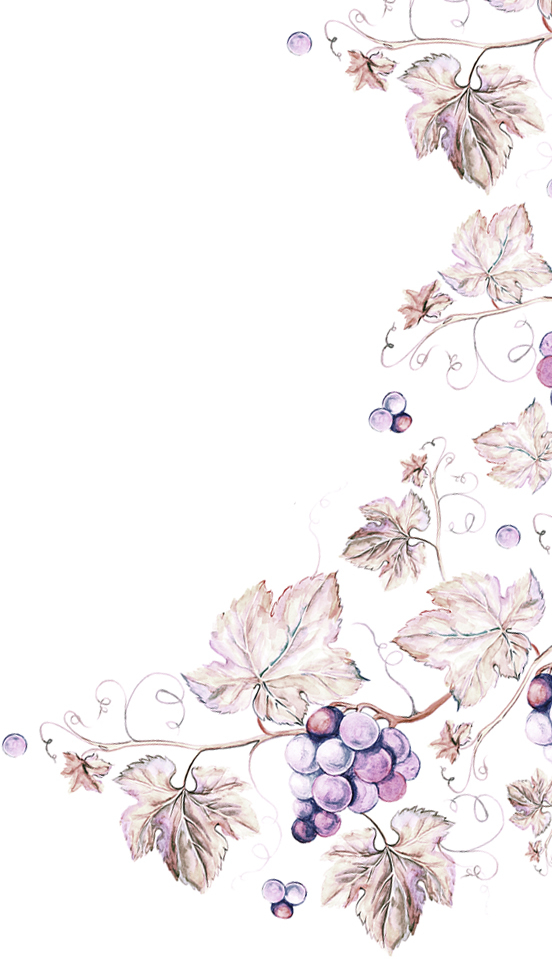

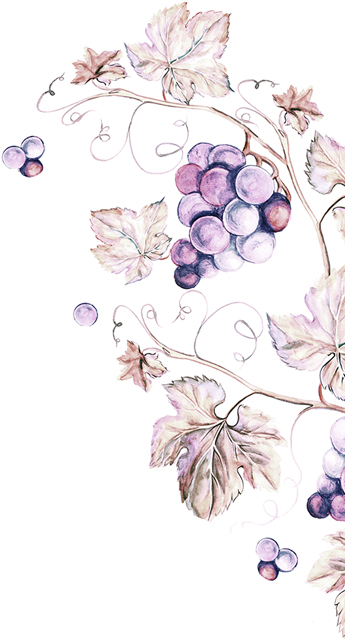
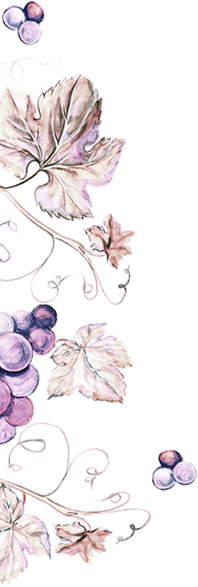
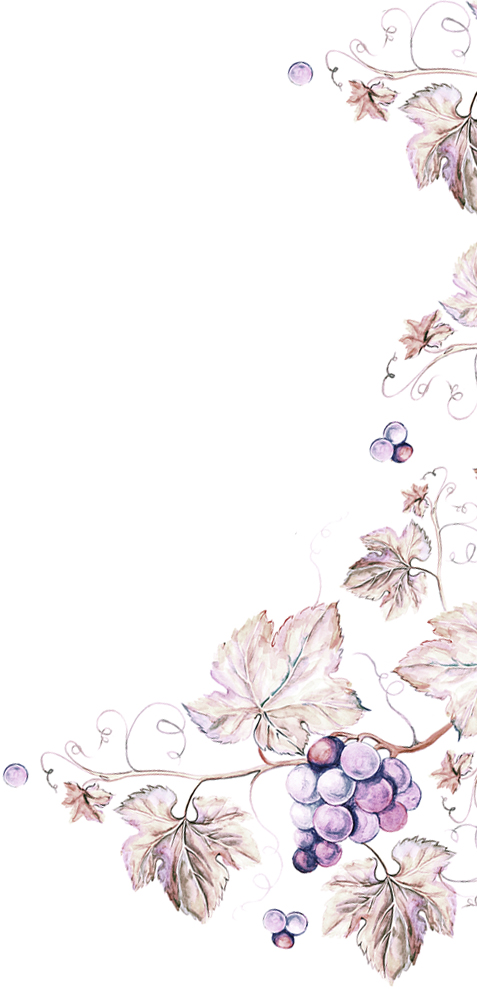

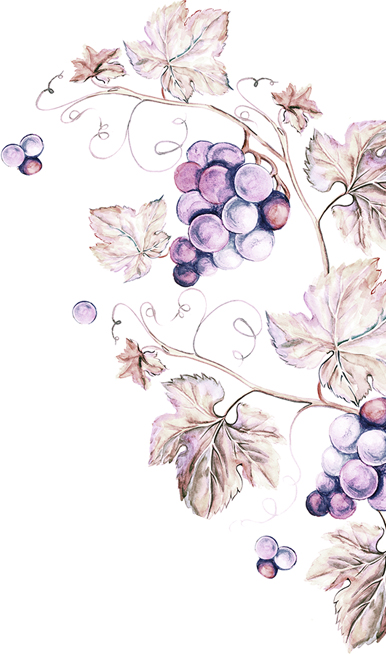
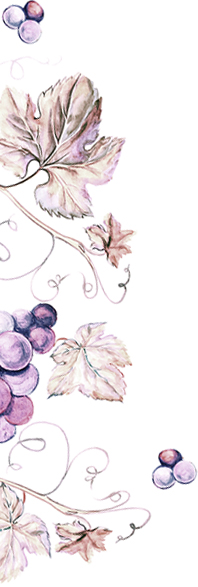
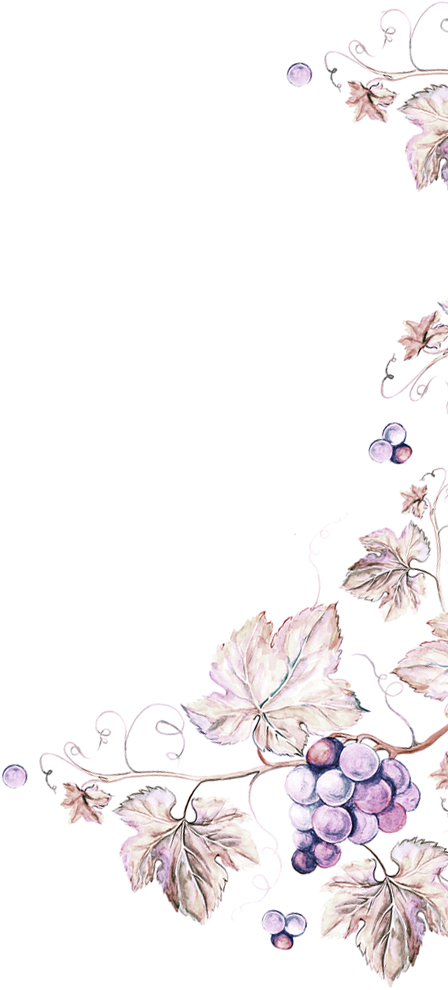

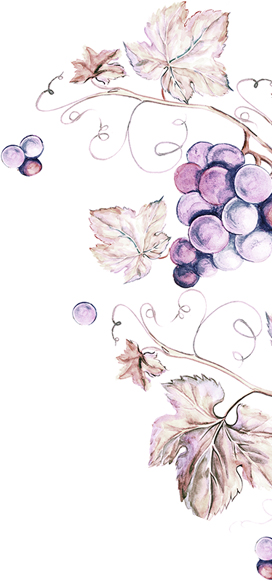
Napa Valley is one of California’s premier destinations, world-renowned for its beauty, award-winning wineries, and Michelin-star restaurants. Its popularity can be confirmed by the 3 million visitors that the valley plays host to every year. Are you ready to explore this little piece of heaven?
The Napa Valley can be an intimidating place, full of vineyards, required reservations, traffic congestion, and a myriad of options for activities. Potential visitors are often overwhelmed by the sheer number of choices available. We’ve tried to take away that pain and distill the valley into consumable bites that make it easy to decide what you want to do and where you want to do it.
Whether you’re seeking outdoor activities, unique winery offerings, the best food the Napa Valley has to offer, or family friendly options, we’ve got you covered. We’ve even supplied two sample itineraries to get your juices flowing and prompt you to make your own plans to visit.
So what are you waiting for? Let’s take a look at what Napa Valley has to offer for you.
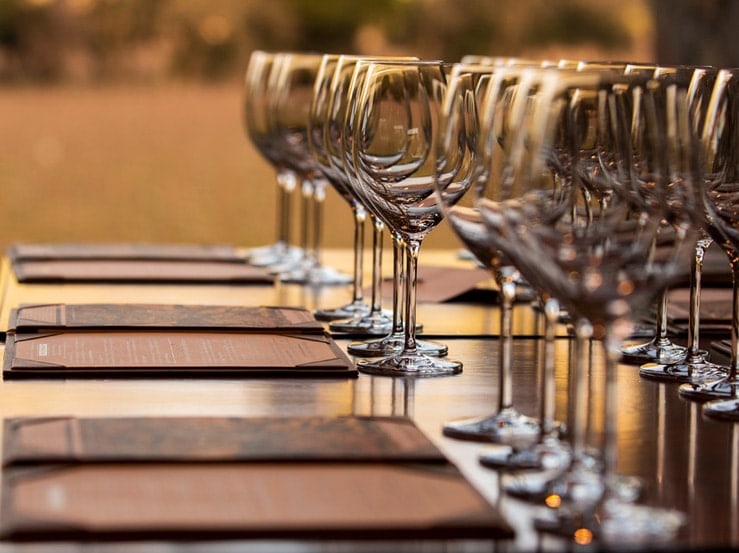
Where is Napa Valley?
Napa Valley is located in Northern California, a short one-hour drive from San Francisco or Sacramento. It is easily accessed via car from San Francisco International Airport, Oakland International Airport and the Sacramento International Airport. (While there is no train service to the Valley, tour buses are available from multiple California cities.)
The unique terroir has made the Napa Valley the premier wine-growing region in the state, with more than 450 wineries dotting the landscape, producing over $5 billion in annual revenue.
The valley itself is only 30 miles long, spanning from the city of Napa north to Calistoga. Highway 29 runs the length of the valley, as does the Silverado Trail, both offering ample opportunity to stop and taste the bounty of the region.
Napa Valley History
When California became part of the United States in 1850, Napa County was formed and became one of the original 27 counties within the state. The area was home to cattle ranchers and farmers, and later became the center of silver mining in the state.
In 1859, the first winery was established in Napa. Two years later, Charles Krug opened his commercial operation in St. Helena, which spawned a whole new agricultural endeavor in the valley. Early pioneers included Krug, Schramsburg, Beringer and Inglenook, all still in existence today.
Over the years, the valley has remained a strong agricultural bastion within the state, with grapes, fruit, and nut trees being the primary crops throughout the nineteenth and early twentieth centuries. The valley has endured Prohibition, as well as nasty infestations of grape phylloxera, which devastated much of the vines in the late 1800s and again in the 1980s. Wine grapes are now the mainstay of the Napa Valley, with approximately 90% of available agricultural land planted with this wine-making fruit.
Also of note are the mineral hot springs located at the northern end of the county in Calistoga. This natural geologic phenomenon gave rise to numerous spas and resorts in the late 19th century, spawning a new wave of tourism. Calistoga soon became a destination for city dwellers to come and relax and “take the waters,” and remains so today.
Napa Valley Towns
Napa Valley is comprised of 6 cities: Napa, Yountville, Oakville, Rutherford, St. Helena, and Calistoga.
Napa
Napa
Napa is the southernmost city in the valley and is the largest, both in terms of acreage and population. The county seat, it is home to several historic districts, the Oxbow Market, numerous wineries, and a vibrant downtown through which the Napa River flows. One of the state’s oldest cities, it was once home to a large number of tanneries, taking advantage of local cattle ranching operations and giving birth to Napa/Nappa leather.
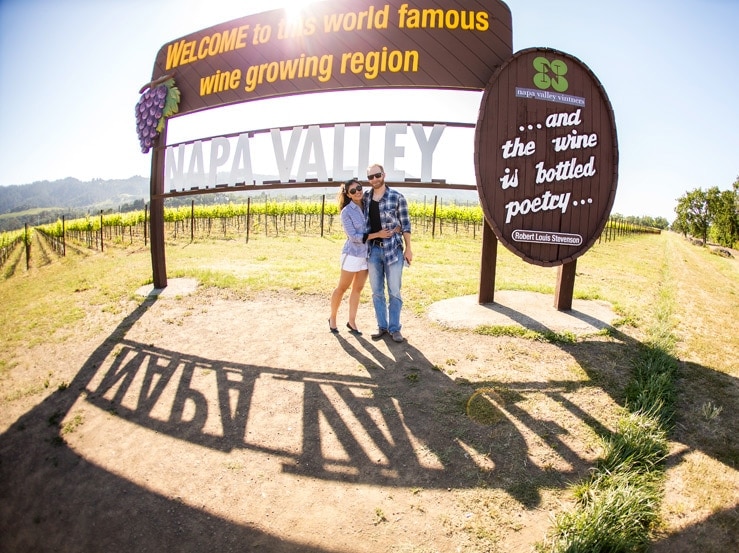
Yountville
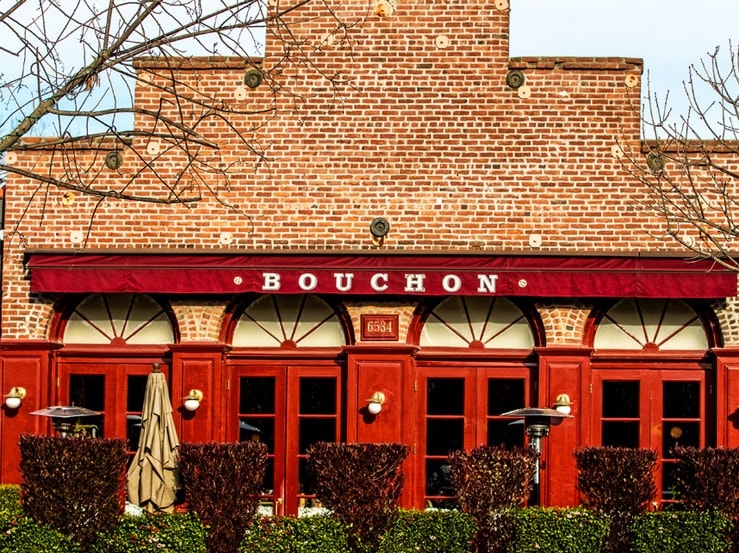
Yountville
Winding your way north, you’ll next hit upon Yountville, named after pioneer George Yount, who established one of the valley’s earliest vineyards. Small in size with a population of just 3,000, it’s large in reputation. Yountville is home to several Michelin-starred restaurants—including Thomas Keller’s famed French Laundry and Bouchon—as well as champagne house Domaine Chandon (and 25 other wineries), the Art Walk, and the Napa Valley Museum.
Oakville
Oakville
Heading north on Highway 29, Oakville is the next town on the map, given its name due to the heavy population of oaks throughout the area. Both the oaks and the visitors on any given day far outnumber the residents (71 at last count!). But don’t let the small-town ambience fool you. Oakville has a large reputation, with wine heavyweights such as Robert Mondavi owning vineyards here. It’s also home to the famed Oakville Grocery, which has been supplying sustenance to travelers since 1881.
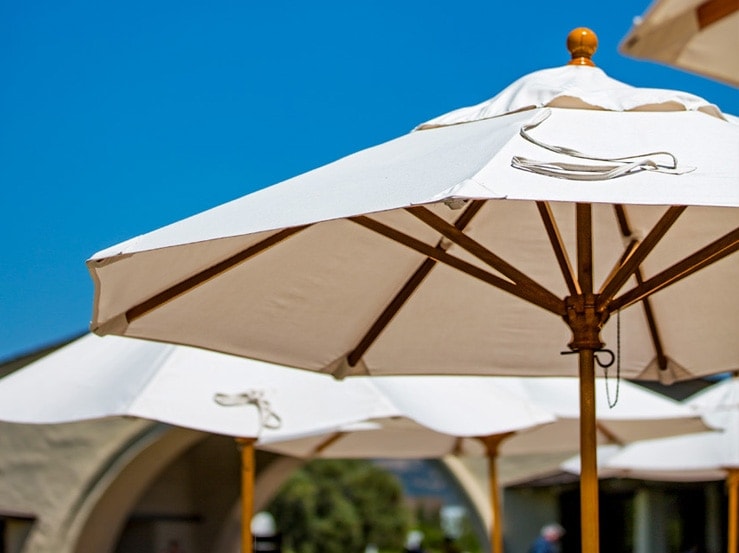
Rutherford
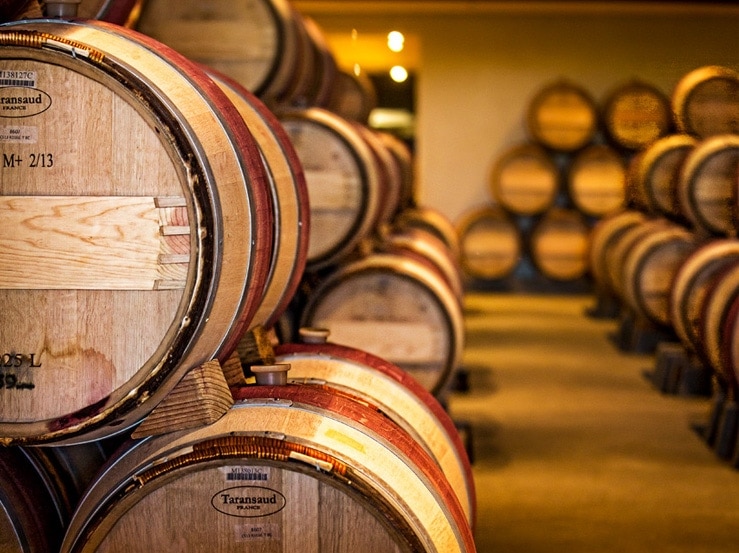
Rutherford
Rutherford is smack-dab in the center of the valley. Founded by Thomas Rutherford, the son-in-law of George Yount, this area produces cabernets with a very distinct flavor, known as “Rutherford dust.” You can taste this extraordinary wine at most of the town’s 32 wineries, including one of the valley’s oldest, Inglenook (now owned by Francis Ford Coppola).
St. Helena
St. Helena
St. Helena has a small-town feel, but is big on grapes, with 416 vineyards currently located within its boundaries. There is a true downtown, which starts at Gott’s Roadside (originally known as Taylor’s Refresher to the locals) and winds for 5 blocks. You can peruse fine art, shop in small boutiques, and drool at the confections at Woodhouse Chocolates. Once home to M.F.K. Fisher, it is a food-lover’s dream, with such eateries as Michelin-starred Terra, Charlie Palmer’s Harvest, and Wine Spectator’s Greystone Restaurant.
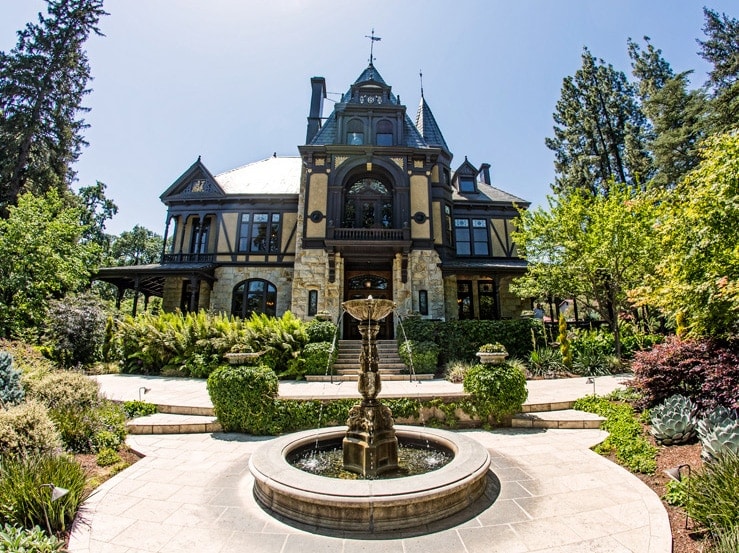
Calistoga
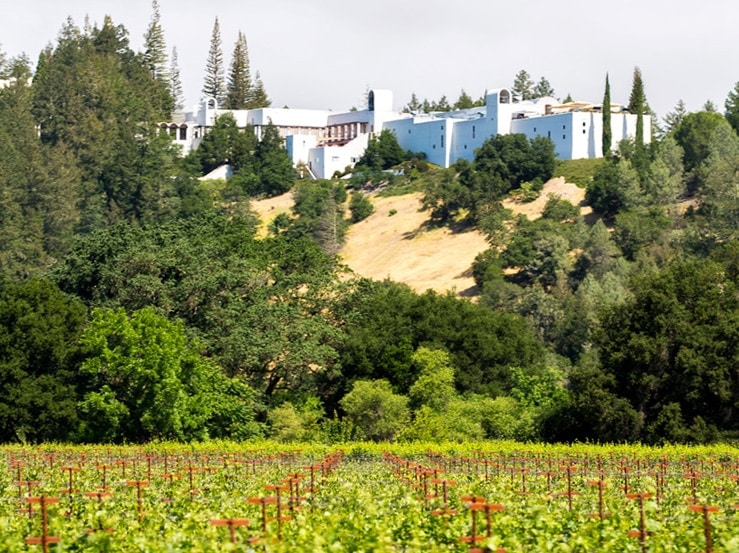
Calistoga
Calistoga marks the northern or upper end of the Napa Valley. Nestled against the hills, the town is well known for its mineral hot springs. Since the mid-1800s, Calistoga has been a resort destination, where travelers come to take the waters and relax (with a glass of wine, of course!). Home to an eclectic assortment of attractions, including Castello di Amorosa (a 13th-century-inspired Tuscan castle), Old Faithful Geyser of California, hot balloon rides, and Sterling Vineyards, which is accessed via an aerial tramway.
Best Time to Visit Napa Valley
There are definitely better times of the week and year to visit the Napa Valley, but it’s all about what is tolerable to you. So let’s take a look at the variables that can affect your way into wine country.
Napa Valley Weather
Like much of California, the weather in the Napa Valley is fairly moderate, rarely getting below freezing (32°F/0°C). The coldest months are November through March, where lows get to be 36-43°F and highs hit 55-67°F. If it’s rain you’d like to avoid, then November through March will be your least favorable months.
Heat comes into the valley from June through September, and it’s not unusual for the temperature to hit 90 degrees in the center of the valley. The most moderate months, weather-wise, are April, May, and October.
Traffic
You may think that traffic wouldn’t be a factor, but it most certainly is, as there is limited ingress and egress. The Napa Valley is served by only two main roads—Highway 29 and Silverado Trail—neither of which has more than 2 lanes in each direction (and one lane in some portions). And it is these two roads that have to serve the residents, tour buses, farm equipment, and those 3 million tourists I mentioned earlier. So, a word to the wise, weekdays are always better than weekends when it comes to crowded roadways.
Seasonally
There are definitely peak seasons for visitors to the Napa Valley. Summertime is the obvious culprit. This is traditional vacation time for Americans and most of the industrialized world, the weather is nice, and who wouldn’t want to sip wine from a sunny veranda overlooking vineyards? But vacation time also means booked wineries, congestion on the roads, increased hotel rates, and long waits at restaurants. If your only available time to visit the Napa Valley is in the summer, try to do so during the week (Tuesday-Thursday).
Harvest and crush are also peak times in the valley. Typically harvest will take place from late August to October, depending on the weather, the type of grape and its optimum sugar content. It’s a glorious, if busy, time to visit. Vines are heavy with fruit, vintners are working at a frantic pace to harvest, and you’ll get to see so much more of the wine-making process on tours. The downside, of course, is that it’s a popular event, the roads are even more congested with trucks burdened with fruit, and reservations for accommodations and most restaurants need to be made well in advance. Just know that you’ll pay a premium for most of your time in the valley, but it’s a wonderful ritual to witness.
You’ll face the least crowds November through April, so basically late fall through early spring. You’ll also see more reasonable rates on accommodations during these months, as well as smaller crowds at the more popular restaurants…actually make that restaurants in general.
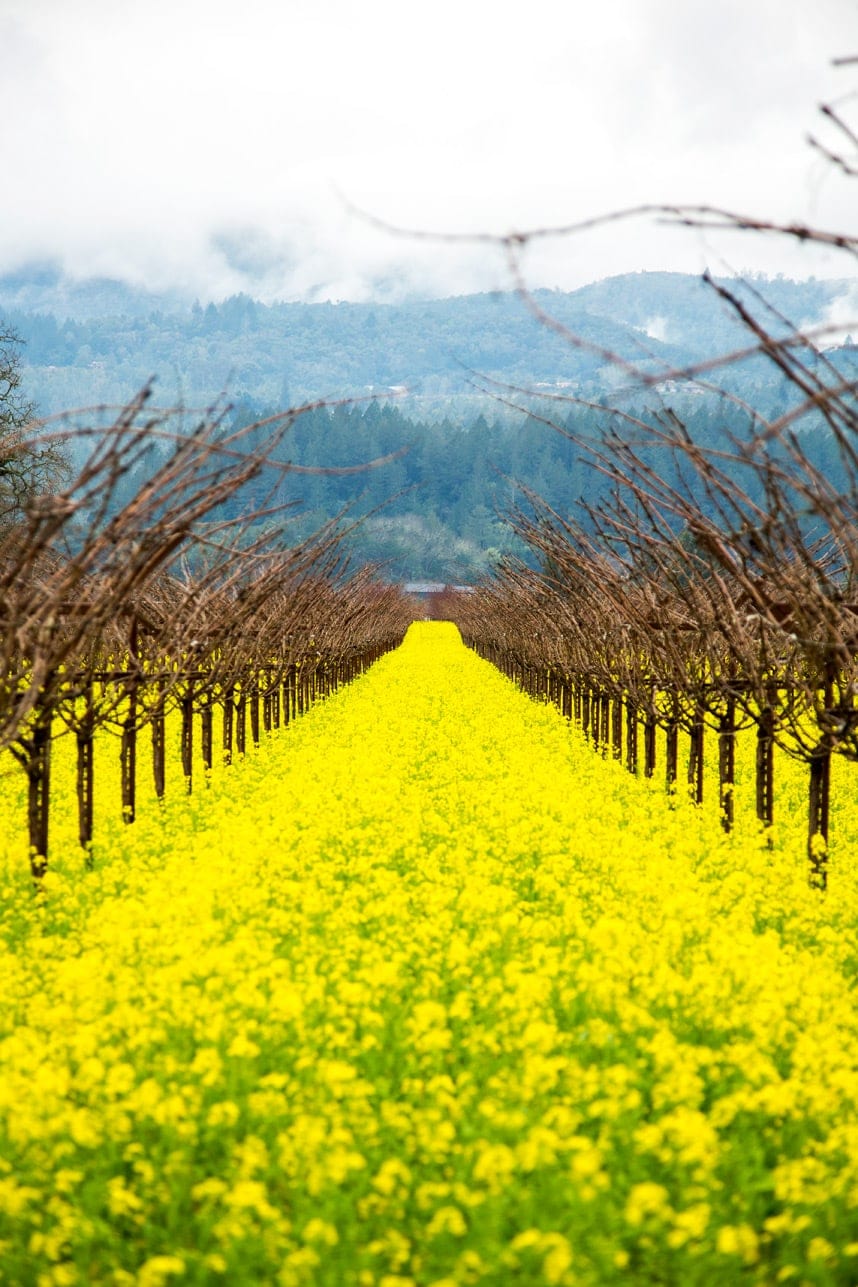
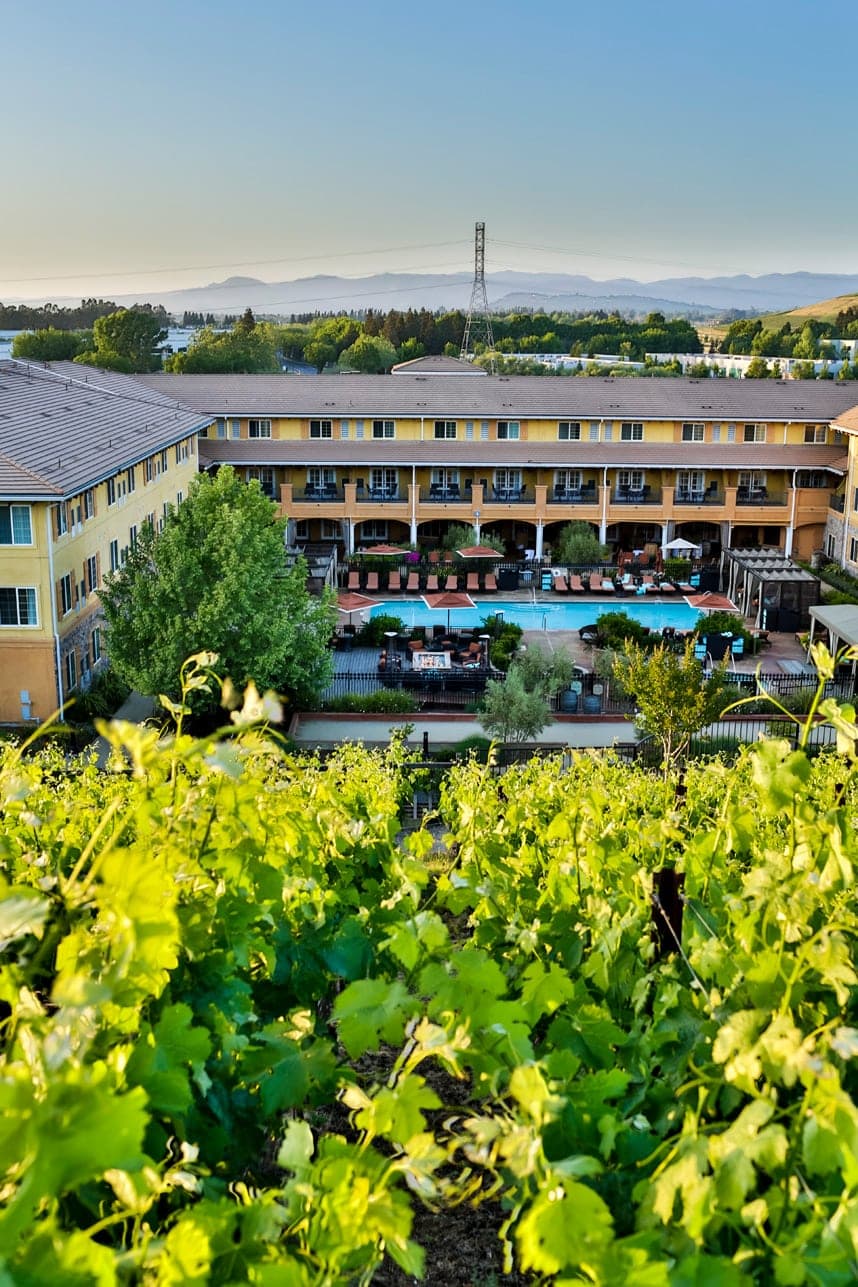
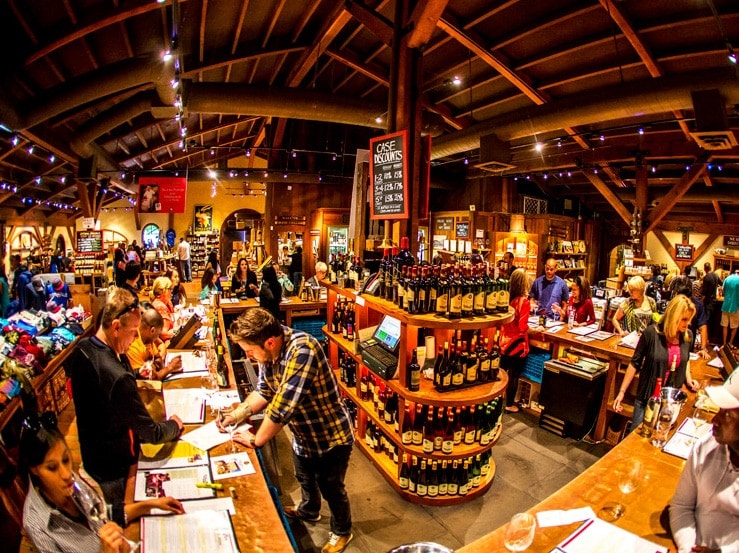
Things to do in Napa Valley
The most obvious attraction to the Napa Valley is its vineyards, wineries, cave tours, and various and sundry other activities associated with wine. Almost as notable are the culinary delights found here (of which we have dedicated a whole section), as well as the hot mineral spring spas.
But that’s not all there is to do in Napa Valley. Whether you are single, a couple or a family, want adventure, cultural activities, or just plain fun, there is something here for everyone. There are parks and hiking trails, golf and hot ballooning, film and music festivals, theaters and art galleries…and so much more.
So let’s take a look at your options.
Napa Valley Wineries
Napa Valley is California’s premier wine-growing region with over 700 grape growers, 475 physical wineries, and more than 1,000 brands of wine. So what makes this area particularly well suited to growing grapes?
The climate and soil are the two primary reasons (although talented winemakers certainly have a large hand in the success of the region as well). The Napa Valley has a dry, Mediterranean climate—similar to Tuscany, Provence and the Rhone Valley—that creates an ideal growing environment for grapes. The temperate climate allows for a shorter dormancy period, longer growing season, and very little frost, which can harm the fruit and the vines.
Then there is the soil. According to the Napa Valley Vintners Association, the valley contains 33 soil series with more than 100 soil variations, and half of the soil orders that exist within the world can be found in the Napa Valley. Imagine that, 50% of the soil orders found on the entire planet live in just 789 square miles in the center of California!
If you’re game for tasting some wine, taking a tour, or learning more about the process of winemaking, then you’ll have no shortage of options. Over 400 wineries have tasting rooms, a good portion offer tours, and many have special features (gardens, art galleries) or events (blend your own wine, food & wine pairings).
It would be impossible to list every single winery in the Napa Valley. What we can do is provide you with some suggestions for some of the most popular or unique wineries in each town in the valley.
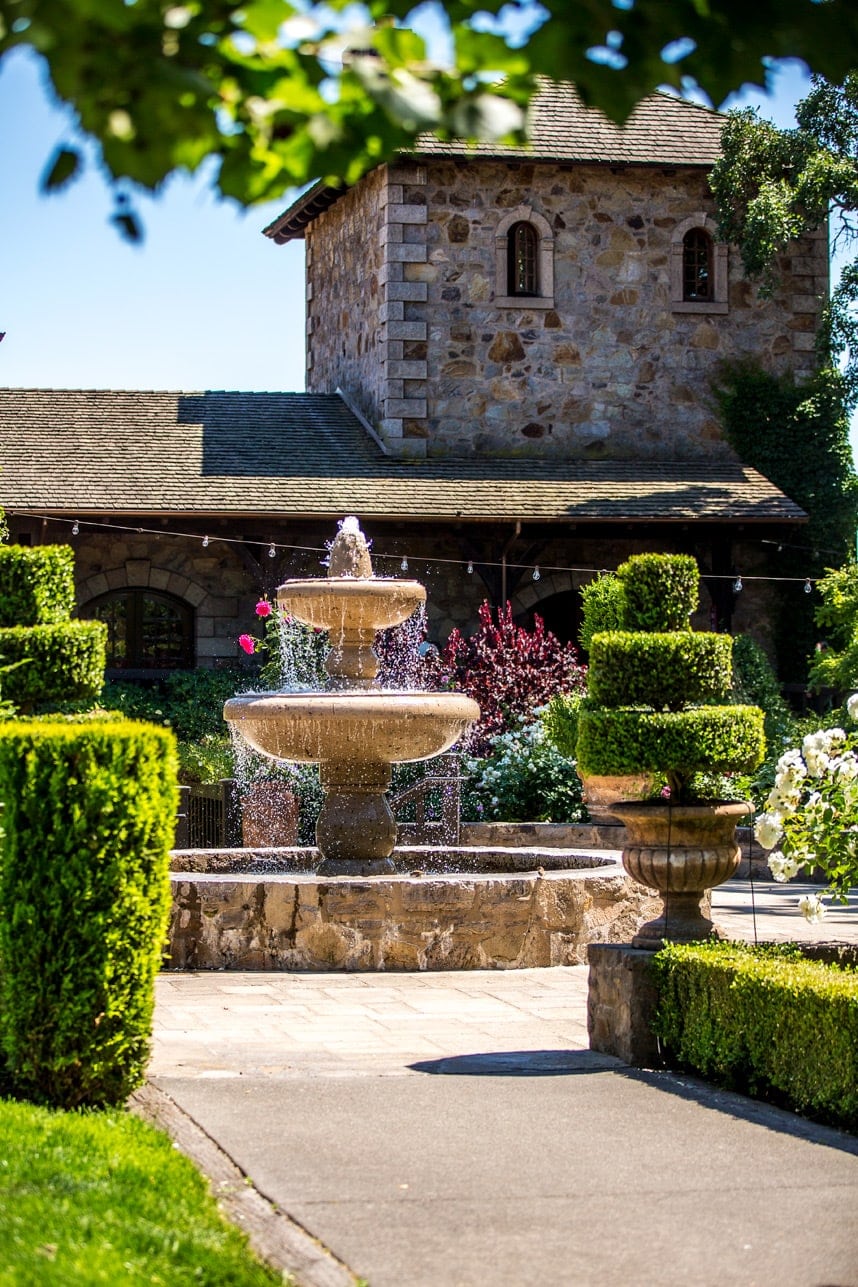
Napa Wineries
Artesa Winery: You’ll be impressed by this magnificent winery set high above the city of Napa. Avant-garde in style and literally set into the hillside, you will marvel at the architecture, the grounds, and the wine itself. Offerings include reds, whites, and sparkling wines, and if you have time, check out their weekly Vino Con Queso pairing for a real treat.
The Hess Collection: This family-owned winery offers several food and wine pairing options, including Vine to Table (vineyard tour and 3-course lunch with wine pairing), Tour of the Palate (museum tour, 3-course wine and food pairing), Wine & Chocolate Experience, and the Tour, Wine & Cheese Experience. Additionally, the Hess Art Collection is a definite must-see for art enthusiasts.
Palmaz Vineyards: This Napa winery has the largest wine caves in the whole valley. Spanning 100,000 square feet, they are about ten times the size of most caves in the valley. In addition to this unique feature, the owner is a renowned scientist, having developed the balloon heart stent. He has taken his passion for science and studied wine on a molecular level, making cabernet sauvignon, riesling and chardonnay using high-tech methods.
Robert Sinskey Vineyards: This vineyard practices the whole farm philosophy, sharing vineyards with their sheep, growing culinary crops, and maintaining their own hives for both pollination and honey. Dedicated to the culinary experience, Sinskey offers five different culinary experiences, from small bites to full meals that include a tour of the vineyard, farm, and cellar.
Stag’s Leap: Located along the Silverado Trail, this 240-acre winery is hidden in a valley in the valley, making for unique terroir and some marvelous wine. The 19th-century stone winery lends to the overall appeal, although it can be hard to find, as there are no signs. Take their 90-minute tour and tasting (all visits by appointment only) and you’ll feel like you’ve gone back in time, amongst the old stone cellars and musty wine bottles.
Yountville Wineries
Bell Wine Cellars: Considered an artisanal winery, Bell Wine Cellars handcrafts small batches of limited-edition wines. After harvest, a large semi pulls up onto the property containing the mobile bottling line and they set to work on their cabernets, pinots, syrahs, zinfandels, and other great wines. Stop by their tasting room, enjoy a glass or two of wine, and play some bocce on the patio.
Chiarello Family Vineyards: Owned by famed chef Michael Chiarello, this is a small family-owned vineyard with only 20 acres of vines. Using sustainable practices, Chiarello has revived 94-year-old vines and is now crafting five different wines. The tasting salon is located inside V Marketplace off Highway 29, offering a standard Vino Tasting or, for those with an appetite, the Antipasti Tasting.
Domaine Chandon: Founded in 1973, this vineyard is known for its sparkling wines, which is not surprising as its parent company is Moet & Chandon, the well-known champagne house in France. The tours are very educational, as is their class “Sparkling Deconstructed Tasting,” where you learn not only about crafting a sparkling wine, but see the process from start to finish, and taste everything from a base wine to several of their final products. The terrace is also a wonderful place to wind down your day, sipping bubbly.
Hill Family Estate: This family-owned winery is comprised of 12 vineyards covering 120 acres. Owner Doug Hill manages vineyards for the likes of Silver Oak, Ramey and Duckhorn wineries, and takes special pride in his own label. Check out their Secret Garden Tour or visit their tasting room and see the antiques (and baseball bats) that have been refinished with stains made from their wines.
Jessup Cellars: Located a few doors away from the French Laundry, Jessup has one of the friendliest tasting rooms in the valley. So friendly, in fact, that even your dog is allowed on the premises! (A rarity amongst wineries.) Crafting ultra-premium wines, Jessup is also known for having one of the best wine clubs in Napa Valley.
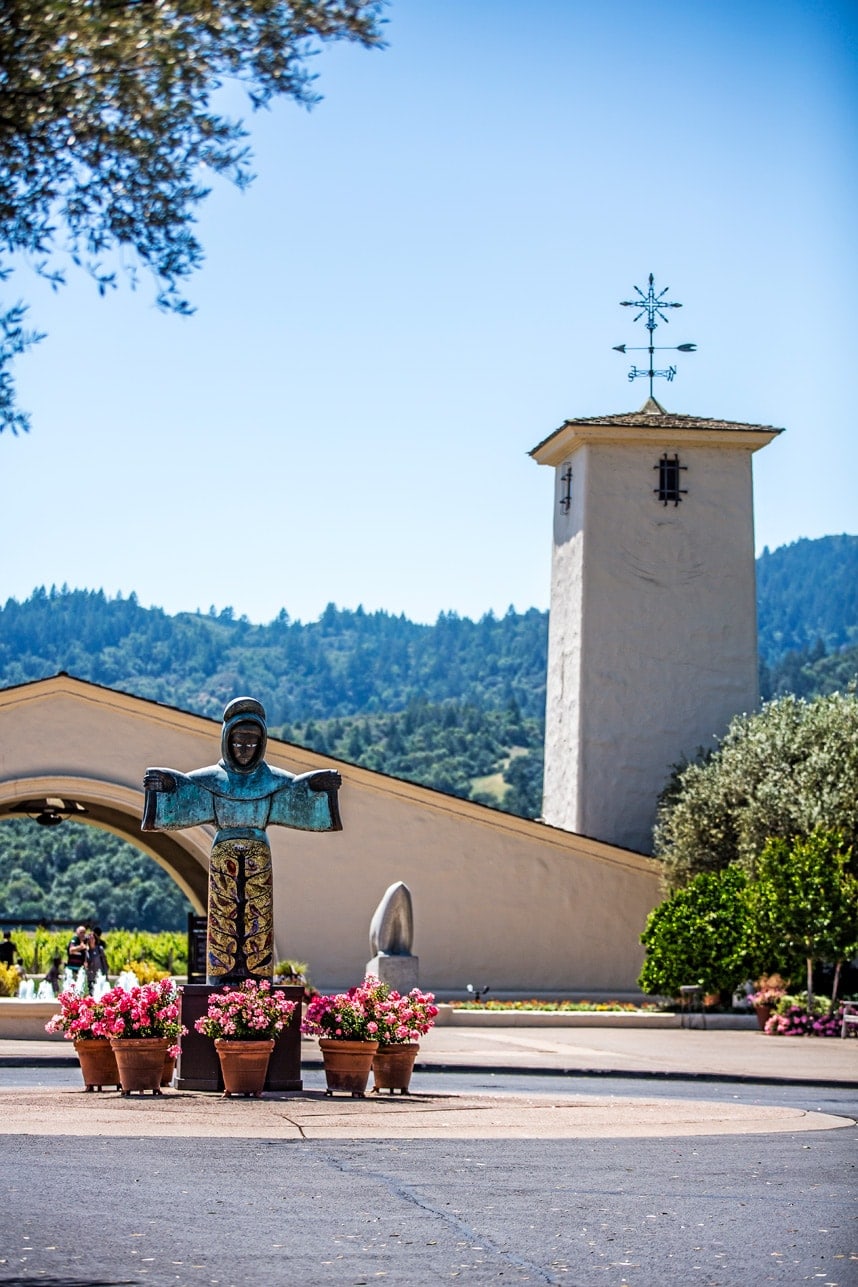
Rutherford Wineries
Beaulieu Vineyard: Established in 1900 by Georges de Latour, this winery has the fine distinction of remaining open during Prohibition due to its relationship with the Catholic Church (for which it supplied wine for communion). The “Rutherford rust” phenomenon can be tasted in many of this winery’s offerings, which are predominantly reds. Their signature wine is the BV Georges de Latour Cabernet Sauvignon. Make sure you try this delicious offering.
Grgich Hills Estate: This winery, established in 1977 by Vintner Hall of Fame member Mike Grgich, is committed to sustainable farming techniques. They eschew the use of pesticides and artificial fertilizers in the vineyards and rely on solar power for their winery. Their wines are served by U.S. and French presidents, as well as Britain’s Queen, but are accessible to anyone who walks in the door!
Mumm Napa: It’s all about the technique at this offshoot of French champagne house, G.H. Mumm. Using a process called Methode Traditionelle, Mumm Napa handcrafts its sparkling wines, carefully selecting the right grapes and using only the first, most pure pressing of each batch. And who wouldn’t love a wine that helped the San Francisco Giants celebrate their World Series wins?
Peju Winery: This Rutherford winery has a number of culinary offerings, including the Wine & Culinary Exploration, Small Farm Cheese and Wine Pairing, Farm to Table Luncheon (3 courses and a chat with the chef!), and an Interactive Culinary Experience, where you get to do hands-on prep with their chef, scout and pick ingredients for your meal, and then enjoy a feast with wine pairings. Peju is also known for their wonderful sparkling wine.
Round Pond Estate: This multifaceted winery produces not only wine, but olive oil, vinegars, and other taste treats from their land. When you select a culinary experience from Round Pond, it will be filled with bounty from their garden, including their own eggs, honey, produce, and herbs. Round Pond offers several wine and food pairings: Il Pranzo (estate and garden tours, tasting of wine, olive oil and vinegar, lunch and wine pairing), Garden to Table Brunch (garden tour, cooking demo, brunch and wine pairing), and the Signature Tour & Lunch (tour the estate, winery, olive mill and vinegar acetaia, lunch and wine pairing). Don’t forget to take home some of their artisan syrups, in addition to their wine!
Jessup Cellars: Located a few doors away from the French Laundry, Jessup has one of the friendliest tasting rooms in the valley. So friendly, in fact, that even your dog is allowed on the premises! (A rarity amongst wineries.) Crafting ultra-premium wines, Jessup is also known for having one of the best wine clubs in Napa Valley.
St. Helena Wineries
Beringer Vineyards: Founded in 1875, this is one of the oldest operating wineries in the Napa Valley, listed in the National Register of Historic Places and as a California Historical Landmark. Beringer’s large grounds give you plenty to see and tour. If possible, opt for the Reserve Tasting Bar at the Rhine House and take a seat outside to enjoy the gorgeous weather and relax.
Del Dotto Vineyards: Visitors are in for a treat here, not only with the wine but the food as well. Executive Chef Joshua Schwartz has worked at the French Laundry, Bouchon and Per Se, all restaurants with at least one Michelin star. This family owned winery focuses on small-batch wines, and offers barrel tasting in their caves, along with a rotating list of food-and-wine pairing events led by Chef Schwartz.
Charles Krug: This is now the oldest operating winery in Napa Valley, founded in 1861. Owned by the Mondavi Family since 1943, this winery is helmed by third-generation Mondavis and has one of the few female winemakers in the valley, Stacy Clark. Stop into this historic winery for a tour and a taste of their Bordeaux-style wines.
Heitz Wine Cellars: For over 50 years, quality wine has flowed from Heitz vineyards. Now using sustainable practices, with the majority of their vineyards certified organic, they produce cabernet, zinfandel, sauvignon blanc, chardonnay, port, and a fairly rare grignolino. Grignolino is common to Northern Italy, not Napa Valley, but has been produced here since Day 1 and worthy of a trip to their tasting room to give it a try.
Newton Vineyard: Sitting atop Spring Mountain on the west side of town, this winery provides some breathtaking views of the valley. Newton is known for producing wines without filtration, a rarity amongst Napa Valley wineries. A visit to the winery for a tasting or tour will also allow you to wander in their formal English gardens, which are meticulously manicured and evocative of the British estates of old.
Calistoga Wineries
Castello di Amorosa: This one-of-a-kind winery is an architectural icon. Styled on a 13th-century Tuscan castle, it comes complete with drawbridge, defensive towers, chapel, and even a torture chamber. You can explore the castle on a tour or on your own and then enjoy some Italian-style wines produced on site.
Chateau Montelena: This winery is well known for it’s excellent wine, but many come to see the chateau itself, constructed in 1888 from stone that is between 3 and 12 feet thick. While the chateau is very French, outside you’ll find Jade Lake, built by a former owner. Asian-inspired, it once held a Chinese junk that seemed very out of place next to the chateau and in Napa Valley in general. The Estate Tour is highly recommended, as is the wine.
Midsummer Cellars: This micro-winery is the passion of Rollie Heitz, whose siblings run Heitz Cellar in St. Helena. Rollie makes primarily cabernet using single-vineyard grapes, but also offers a malbec, rosé, pinot blanc, and a unique GMRV (grenache blanc, marsanne, roussanne, and viogner blend). The wines are primarily direct to consumer and not found through traditional distribution channels, so stop by and maybe you’ll get a tour from Rollie himself.
Schramsberg Vineyards: This is one of the oldest wineries in the valley founded in 1862. While the current owners have only owned it since the 1960s, they continue to adhere to century-old traditions to produce some of the best sparkling wines, of which they have an impressive array. That array is primarily stored in caves that were dug out of volcanic rock in the late 1860s and now hold over 2.5 million bottles.
Sterling Vineyards: What makes this winery so unique is not only its perch 300 feet above the town of Calistoga, but the aerial tramway that takes you to the winery itself. After the tour, you’ll end up at Sterling View Terrace which will provide you with one of the most gorgeous views of the entire Napa Valley. Truly an amazing sight, and the wine is pretty darn good as well!
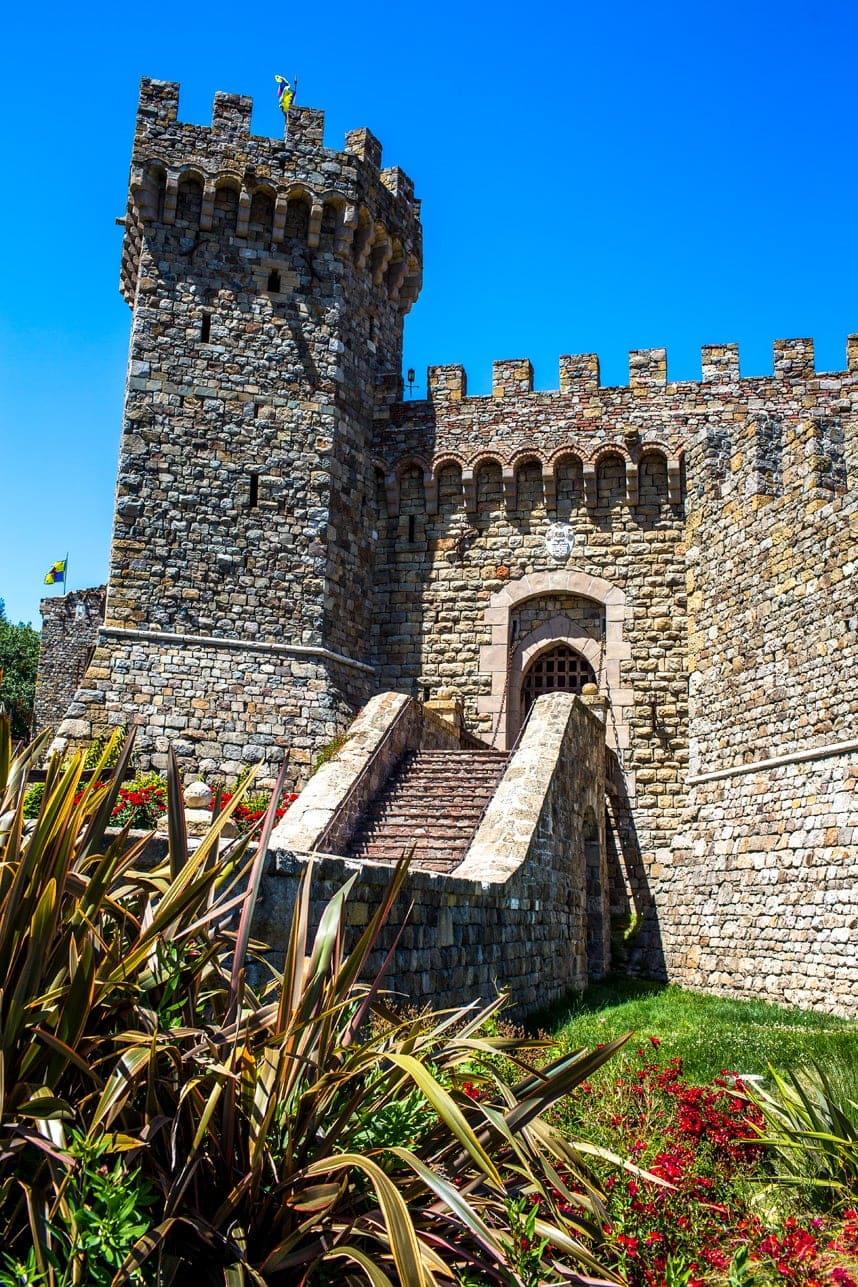
Oakville Wineries
Miner Family Winery: Imagine running a whole winery on solar power. Well, that’s exactly what you’ll find at Miner Winery. That and some really good wine. Producing Bordeaux, Burgundy, and Rhone-style wines, try the “Sommelier Experience” where you will have guided tastings of high-end wines with an in-house sommelier—a perfect learning experience.
Oakville Winery: This winery started life in 1877, under a different name, and was the 9th bonded winery in the state. Now owned by the Pelissa family, Oakville Winery uses primarily heritage vines, farmed organically, to produce single vineyard wines. This makes for some excellent cabernet sauvignons and zinfandels. Check them out at The Napa Wine Company Tasting Room—also owned by the Pelissa family—which is the tasting room and launching pad for “some of Napa’s most notable cult wines and celebrity winemakers.”
Robert Mondavi Winery: This longstanding winery offers one of the more ambitious food and wine programs in the Napa Valley. They range from the simple to the complex and change periodically. Current offerings include an Exclusive Cellar Tasting (wine and cheese/charcuterie accompaniment), Wine and Chocolate Tasting, Wine Pairing with Cheese, Harvests of Joy (tour, 3-course wine-pairing lunch), Garden to Table Dinner (walk tour of the gardens, behind the scenes kitchen tour, 3-course wine-pairing dinner), and the granddaddy of them all, the Five Decades Dinner, which offers wines from each of the last five decades, followed by 4-course wine-pairing dinner.
Rudd Oakville Estate: This winery and its vineyards were built by Leslie Rudd, owner of Dean and Deluca, who knows a thing or two about the finer things in life. The estate’s 55 acres are farmed organically by in-house staff only, and they utilize a mix of traditional French winemaking methods along with American technological innovation. Take a tour here, where you’ll get an amazing education and taste some truly worthwhile wines.
Silver Oak Cellars: Widely known for their cabernet sauvignon wines, Silver Oak is committed to aging all of their wines to perfection, which is typically 24-30 months in barrels and another 18 months in the bottle. (Those barrels are made of oak in their own cooperage in Missouri.) Visit their tasting room which is which has a façade of hand-quarried limestone that was reclaimed from a 1800s flour mill in Kansas.
Napa Valley Wine Train
While the majority of visitors to the Napa Valley use private vehicles for their winery runs up and down the valley, you might consider taking the Napa Valley Wine Train on one of their winery tours (listed below). Utilizing century-old rail cars restored to their original elegance, you’ll be whisked down the valley’s historic rail corridor where you can stop and enjoy wines at one of several wineries. Meals are included on all tours.
- Quattro Vino Tour: stops four times along its 6-hour journey (and includes tastings at 4 wineries and a 4-course meal).
- Castle Winery Tour: a short 1.5-hour tour that includes a stop at Castello di Amorosa for a tour and tasting, and a multi-course gourmet lunch on board.
- Raymond Winery Tour: offering a ride to an exclusive tour and tasting at Raymond Vineyards, followed by a multi-course gourmet lunch.
- Grgich Hills Winery Tour: a 2-hour gourmet lunch tour that includes a stop with tour and tasting at Grgich Hills Estate.
- Ambassador Winery Tour: making stops for exclusive tours and tastings at both Charles Krug and Raymond Vineyards. Includes gourmet lunch.
- Evening Winery Tour: A more intimate after-hours look and tasting at Grgich Hills Estate, followed by a multi-course gourmet dinner.
For those who favor other spirits over wine, there are a number of options for craft beer and more traditional spirits.
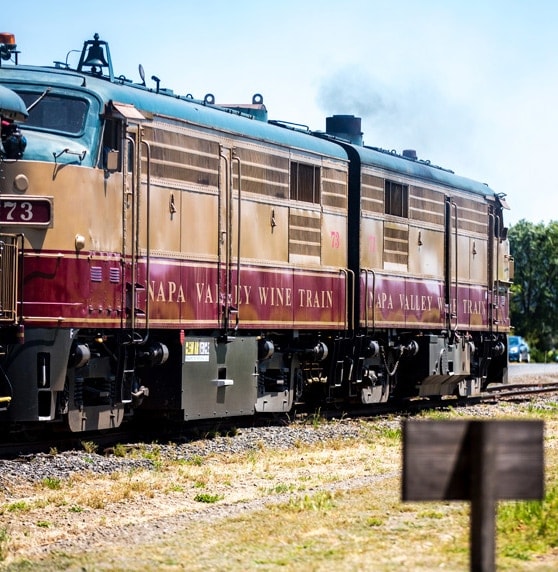
Craft Beer Breweries
For beer lovers, Napa is home to Napa Smith Brewing, Downtown Joe’s Brewery, and Tannery Bend Beerworks. Napa Smith is housed in a renovated sake brewery on the south side of town. Known for their fine ales, they also produce porter, IPA and several seasonal offerings. Downtown Joe’s is a microbrewery crafting beers with high-quality British malts using traditional British brewing methods. Offerings include a variety of ales, wheat beer, porter, stout, and even a malt liquor on occasion! Tannery Bend Beerworks is a new nano-brewery from chef Tyler Rodde and partners, who bring the taste of the great beer cultures of Belgium, Germany and Ireland to the Napa Valley.
Mad Fritz in St. Helena is the brainchild of two winemakers who wanted to craft ales and lagers with “an emphasis on controlling the raw materials.” They use local artesian spring water, locally grown hops and single variety barleys to produce stouts, lagers, and a wide variety of ales. Then we have the Calistoga Inn & Brewery in…Calistoga (aka Napa Valley Brewing Company). This boutique brewery has a 7-barrel brew system that produces 4 regular house brews along with 2 seasonals at any given time. Wheat ale, porter, IPA, pilsner, stout, and red ale are among the regulars on tap.
Spirits Distilleries
When it comes to spirits, you’ve got two excellent choices to visit, each located at opposite ends of the valley.
Napa Valley Distillery, in downtown Napa, creates over a dozen small-batch and limited release spirits, including Napa Vodka, Old Hollywood Gin, Rumslinger Rum, Bourbon Mash Whiskey, and some unusual items like Papillon Pastis, Meyer Lemon Liqueur, and Crème de Violette.
Head down to St. Helena and wind up a mountain to get to Charbay Artisan Distillery and Winery, and if you’re lucky you’ll get to see the beautiful imported copper stills running with brandy or other spirits. Distilled by hand, Charbay produces whiskey, tequila, vodka, rum, brandy, as well as a nostalgic black walnut liqueur.
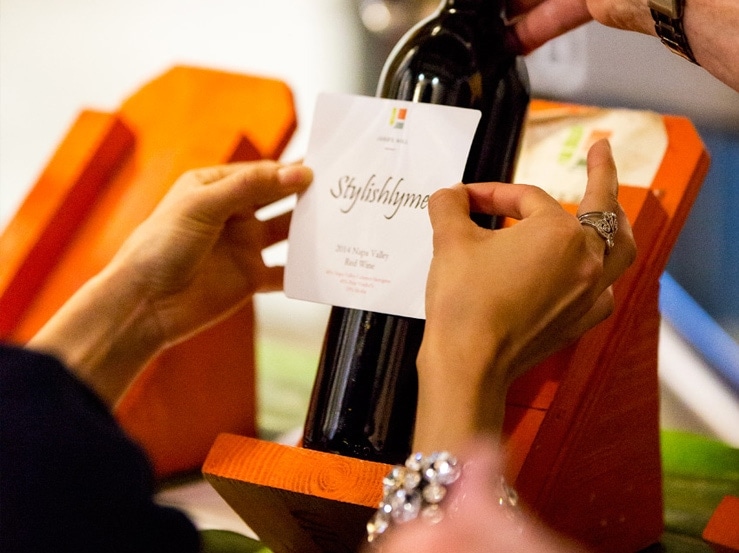
Make Your Own Wine in Napa
Actually, the term “making your own wine” is a bit misleading. What you can actually do is blend your own wine, making a one-of-a-kind bottle (or bottles) based on what appeals to your palate. There are a number of wineries offering this education and tasting experience, and it’s an excellent way to get an introduction to wine and what the Napa Valley is all about.
Check out one of the followings for your own wine-blending experience.
Buena Vista Winery: “Be the Count Blending Experience” offered at this Sonoma winery provides a royally good time where you become winemaker for a day. A little learning, a tour through their Cave of Curiosity, and then to blending your own bottle.
Conn Creek: This St. Helena winery offers a “Barrel Blending Experience®.” Up to 20 guests are given a quick Napa overview, guided barrel tasting, instructions on blending techniques and strategies, and one bottle of your own custom blend.
Franciscan Estate: The aptly named “Mastering the Magnificent: The Art of the Blend” at this St. Helena winery is a mini-competition amongst the attendees. Given all the information you need to blend, bottle, and design a label, your team must then market your blend before a critic. Educational and creative fun!
Judd’s Hill: This winery’s “Bottle Blending Day Camp” provides the education necessary to craft your own personal Bordeaux-style red. After tasting and blending, you’ll actually hand-bottle your wine(s), create your own label, and even pop on the cork and foil wrapping.
Miner Family Wines: In Oakville you can attend the “Oracle Blending Seminar,” based on the winery’s flagship offering. You’ll learn about and taste the 5 varietals that go into the Oracle, and then mix your own to compare.
Paraduxx: Located along the Silverado Trail, Paraduxx offers “The Blend Experience” four days a week. You’ll test your palate and learn to blend three varietals into your own special wine.
Raymond Vineyards: This Rutherford-based winery opens up its St. Helena blending room to students who get to be “Winemaker for the Day.” Don some space-age silver lab coats and a jaunty silver beret and learn all there is to know about blending. Then whip up a bottle of your own custom blend to take home. (You can even order additional cases to be made if you so wish!)
Rutherford Hill: Learn what it takes be a winemaker for a day with Rutherford Hill’s “Interactive Wine Blending Seminar.” Offered several times a year, you’ll get hands-on training for blending wine.
Napa Valley Spas
Almost as famous as the grape, Napa Valley spas are legendary. From the original hot spring mineral spas of Calistoga to high-end spas at famed resorts Auberge de Soleil and Silverado, there are a wealth of choices for visitors to the valley.
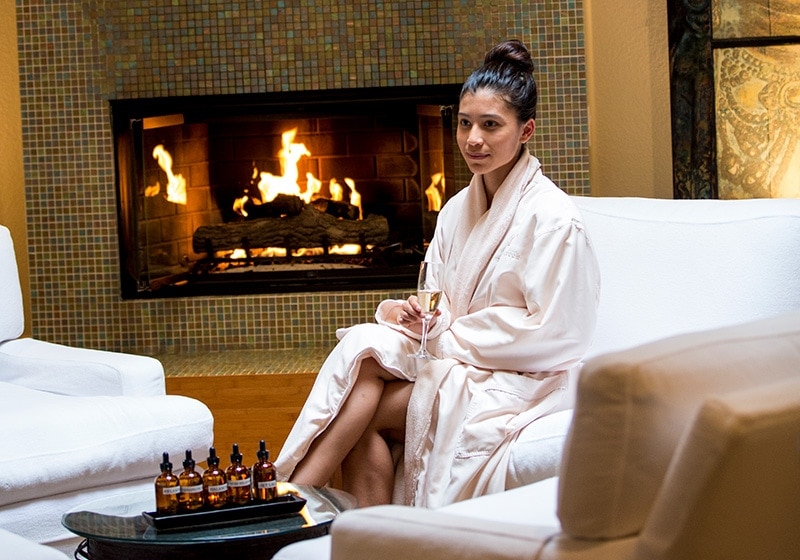
Calistoga Hot Spring Mineral Spas
Calistoga has been known as a resort destination since the mid-1800s, predating the wine industry. This northern Napa Valley town has swarmed with visitors for 150+ years that come to “take the waters,” either for relaxation or to provide some relief from a health issue.
The town sits atop a geothermal aquifer—literally boiling hot mineral water—that spawned the thriving spa industry. Today, spas and resorts line the streets and offer hot mineral soaks, volcanic mud baths, massages, and scrubs to willing and eager participants.
If you’d like to partake in this relaxing non-activity, here are a few suggestions:
Calistoga Spa Hot Springs: Perfect for families, the rooms at this hotel and spa come with kitchenettes and there are four mineral pools for your enjoyment, ranging in temperature. The spa, updated in January and February of 2017, features the requisite mud & mineral baths, as well as a variety of massages.
Indian Springs Resort and Spa: This is not only Calistoga’s but also California’s oldest continuously operating pool and spa facility. Once favored by Hollywood royalty, the 17-acre compound contains a hotel, restaurant, spa facility, pool, and gardens. Both the thermal waters and the volcanic ash for the mud baths are sourced on site.
Mount View Hotel & Spa: This modern spa is located within a boutique hotel that makes relaxation an art form and is perfect for a romantic getaway. Calm surrounds the lobby, the suites, and the spa, where you can enjoy a bath, massage, facial, or romantic couples combo.
For information on all of Calistoga’s spas, check out this list.
High-End Resort Spas
If you’re feeling indulgent, the Napa Valley has some world-class spas to take care of your every need.
Auberge de Soleil: An adults-only resort located in Rutherford, this French-inspired guesthouse is nestled among an olive grove overlooking the valley. In addition to their spa treatments, guests can partake in a self-guided purification ritual that is designed to relax and restore the whole being.
Meadowood Napa Valley: Located in St. Helena, this award-winning hotel offers plush accommodations, a Michelin 3-star restaurant, golf and tennis, as well as an all-suite spa that was voted “Best for the Wow Factor” and “Best New Spa & Wellness Property” at the 2016 Wellness Travel Awards. Spa technicians create a spa experience based on your wants and needs and develop a plan suited to each individual guest.
Silverado Resort and Spa: This large resort, home to the Safeway Open PGA Tour, offers hotel, condo and cottage accommodations in addition to a world-class spa. Offering massage, body scrubs, wraps, facials, and several seasonal spa specials, you are sure to be pampered in the style to which you are accustomed.
Solage Calistoga: This Auberge resort is touted as the #2 Spa Resort in the U.S. by Travel & Leisure Magazine. Offering a full complement of “wellness services,” Solage has 20,000 square feet dedicated to your relaxation and enjoyment. There is the Bathhouse and Mud Bar, which offers a unique 3-part detox treatment that includes the “mud,” the “waters,” and “rest,” the latter of which includes a sensory experience in a state-of-the-art sound chair.
Napa Valley Shopping
There is no dearth of shopping experiences in the Napa Valley. You’ll find quaint downtowns, high-end galleries, and even premium outlets.
In Napa, stop by Oxbow Public Market, Napa’s center of all things food. You can wander the stalls, hear live music, see cooking demonstrations, taste local fare, and enjoy fine wine. Pick up one of Five Dot Ranch brazing kits, sample some Hog Island Oysters, or spend a leisurely hour on their patio licking up Three Twins ice cream.
Next to Oxbow Public Market is The Store at CIA Copia, part of the newly opened Culinary Institute of America. Wander their store for home goods, culinary creations, or their large selection of cookbooks. Frequent food and wine demos are offered, and you can eat dinner at The Restaurant at CIA Copia. (Note: Reservations are limited.)
Napa is also home to a lively downtown, chock full of boutiques offering home goods, clothing jewelry, antiques, fine art, and even cigars. If it’s outlets you crave, then Napa Premium Outlets is the place to go. With over 50 stores, you’ll find designers and familiar brands like Michael Kors, Polo Ralph Lauren, Coach and Calvin Klein, among others.
Yountville is home to V Marketplace, located on Highway 29. Home to specialty retailers, boutiques, galleries, and some excellent food and wine, this is the place for one-stop shopping. You’ll find home accessories, apparel, fine art, jewelry, V Wine Cellar (with over 3,000 wines), as well as the tasting room of Chiarello Vineyards.
On Highway 29 in Oakville stands the historic Oakville Grocery, catering to locals and visitors alike with culinary offerings from throughout the valley. You’ll find local wines, vinegars, honey and produce, as well as all the fixings for a magnificent picnic lunch.
St. Helena is home to a thriving downtown. There is an old-fashioned main street (aka Highway 29) lined with cafes, galleries, and boutiques. It’s the perfect jumping-off point between wineries to wander, grab a bite to eat, and fill your bag with Woodhouse Chocolates!
Spas are not the only game in town in Calistoga, which is also home to a vibrant downtown. Shop the galleries and boutiques, rent a bike and cruise around, grab a bite or taste some wine. Be sure to check out Goodmans Department Store, a Calistoga staple for 130 years.
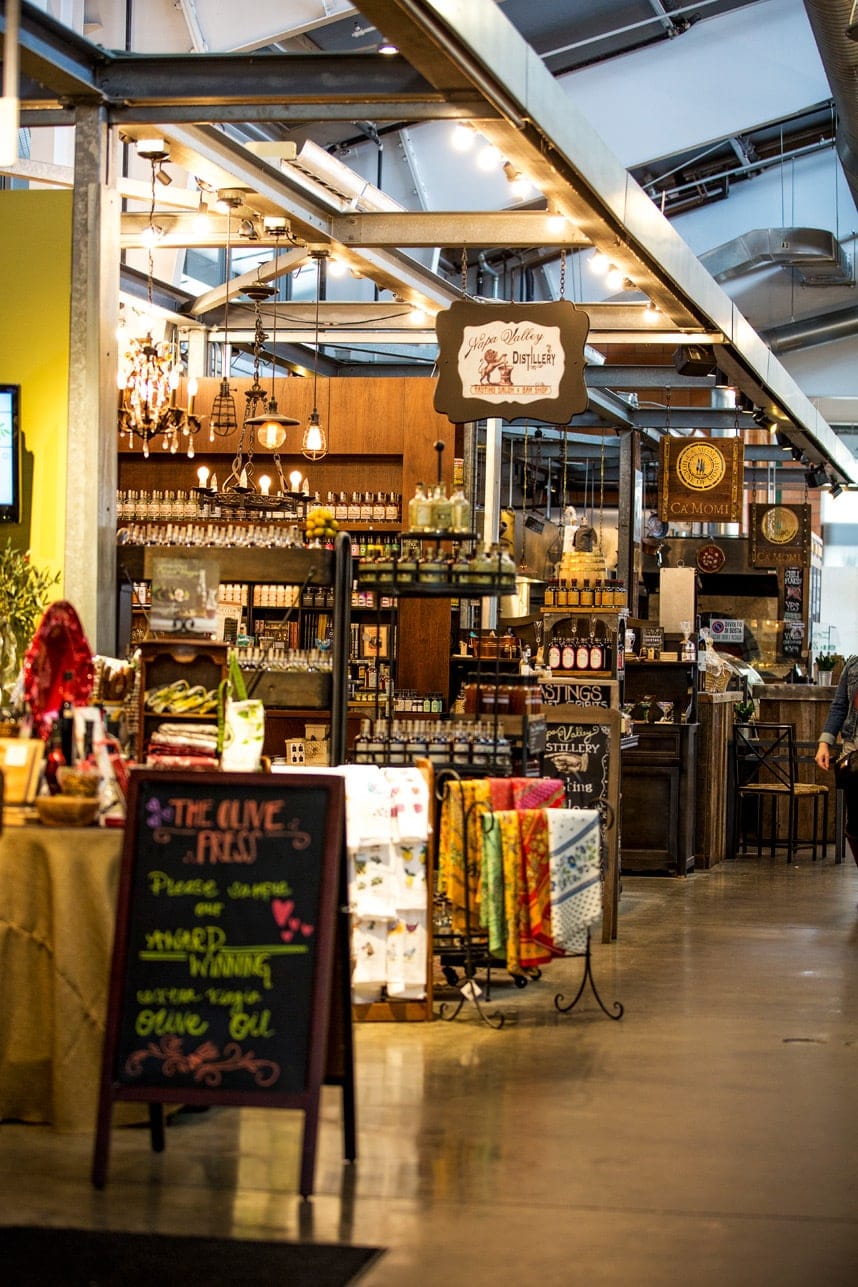
Cultural Attractions
Like all popular tourist destinations, Napa Valley has a wealth of cultural activities so visitors don’t get bored once the wineries have closed or it’s too dark to cycle the trails. Concerts, film festivals, museums, and art galleries are in abundance. Here are the highlights….
BottleRock Napa Valley is the area’s premier rock festival. Held over 3 days at the end of May, it has featured such performers as Maroon 5, Tom Petty, Foo Fighters, Macklemore & Ryan Lewis, Gavin DeGraw, and more. With over 100,000 attendees, tickets can be hard to come by but are certainly worth it for die-hard fans. What could be better than great music, wine, and food?
Festival Napa Valley is a music-lovers dream. Held over 10 days, across 100 wineries, with over 60 events, you can enjoy Opera, Broadway, Jazz, American Spiritual, Irish classical, contemporary singers, full orchestras, and there is even some comedy, dance troupes, and food involved! Something for everyone.
Classical music enthusiasts congregate annually at Music in the Vineyards, Napa Valley’s annual chamber music festival (held in August). This 3-week event is held at wineries up and down the valley and features 30+ musicians of international renown. In addition to this concert, there is a chamber music season in the Napa Valley that runs from November through April, featuring musicians from around the world.
For jazz lovers, check out Brian Culbertson’s Jazz Getaway in June, held at the Lincoln Theater in Yountville and Jamieson Ranch Vineyards, while bluegrass is on tap at Meadow Ranch’s Bluegrass-Fed Concerts from July through October. There is also a concert series at Robert Mondavi Winery, musical picnics in Lyman Park, and Napa Live: Inside and Out, which is a full day of music featuring over 40 bands at 30 venues throughout the downtown Napa.
Napa Valley Performing Arts Center at Lincoln Theater is home to Symphony Napa Valley as well as a variety of musical, theatrical and dance events throughout the year. You can find everything from the
Annual A Cappella Extravaganza, Shaolin Warriors, Sister Act: The Musical, The Naked Musicians, as well as a variety of options for children.
Movies are the ticket at the annual Napa Valley Film Festival, held every November. Featuring the best of independent films, served alongside local wine and culinary delights, you’ll not only see some cutting-edge cinematic endeavors but you’ll be able to rub elbows with some of Hollywood’s elite.
The Napa Art Walk is a biannual exhibit of juried sculpture created by West Coast Artists. Wander around downtown Napa and get an eyeful of large-scale artwork that will amaze and delight. Art is also on tap at the Napa Valley Museum in Yountville. Offering exhibitions and educational programs, you can witness local history, world-class art, and see artists in the making. The diRosa is another museum that showcases Northern California artists, as well as hosting exhibitions and educational programs.
There are also private art collections that have been put on display by Napa Valley patrons. The Hess Collection Winery and Art Museum is focused on 20 living artists that Donald Hess supports and showcases. Mumm Napa is host to the Fine Art Photography Gallery, located in their visitor center. See the work of Ansel Adams, Wayne Levin, and other world-class photographers. Famed muralist Carlo Marchiori has opened CA’ TOGA Art Gallery at his Calistoga estate (Villa CA’ TOGA). Showcasing his paintings, prints, drawings and sculptures, he has “created a captivating, fantastical fusion of Italian Renaissance art, mythological personalities, and contemplative gardens.”
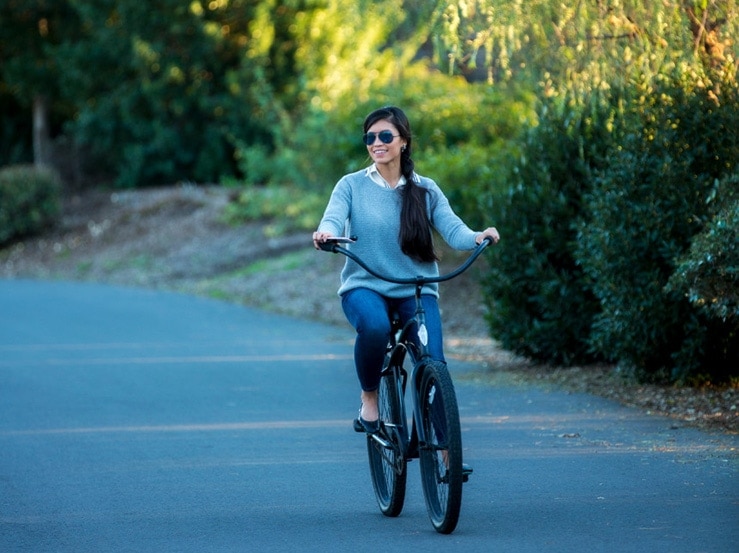
Outdoor Activities
Given the temperate climate in the Napa Valley, it is ripe for outdoor activities. Whether you like to hike, bike, golf, or fly away on a hot air balloon, there are plenty of athletic endeavors and outdoor activities to keep you satisfied.
If chasing a little white ball with a big stick is your game, then you’ll have ample opportunity for golf in the Napa Valley. Offerings include municipal 9-holes to courses that host a stop on the PGA tour, so there is something for everyone. The 10 courses to choose from are: Napa Golf Course at Kennedy Park, Eagle Vines Vineyards & Golf Club, Chardonnay Golf Club, Napa Valley Country Club, Vineyard Knolls Golf Club, Silverado Resort (2 courses), Vintner’s Golf Club, Meadowood Resort, and Mount St. Helena Golf Course. Most of these courses also offer tennis courts, as does the Villagio Inn and Spa.
Biking has always been a popular activity in Napa Valley, with its gently rolling hills, bucolic lanes, and beautiful scenery. You have the option of bringing your own bike and making your own way, renting a bike from a local shop, or participating in a bike tour.
St. Helena Cyclery has bicycles for rent, and even offers a delivery option to your hotel. Options include hybrid bikes for easy pedaling to high-tech carbon road bikes for more hard-core cyclists. Down the street at Clif Family Winery you can rent a cruiser and take the Tour de St. Helena, an 8.4-mile self-guided bike tour through the area. Once you’re done, you can enjoy a glass of their wine along with some of the tasty offerings from their Bruschetteria.
When it comes to bike tours, you have a variety of options. Popular travel company Backroads offers several multi-day bike tours of Napa Valley and California wine country, as does Getaway Adventures. For single-day tours, you can try Napa Valley Bike Tours, which offers guided bike tours, private group bike tours, and self-guided bike tours, as well as bike rentals. Calistoga Bikeshop has similar offerings, from a $28 one-day bike rental to multi-day customizable guided bike tours.
If you’re on your own, there are a number of routes you can take. The Napa Valley Vine Trail is an ambitious project dedicated to building a 47- mile walking and biking trail connecting the entire valley. Right now it consists of 12.5 miles from Napa to Yountville. Additional routes can be found by checking out this Napa Valley Bike map, which is a downloadable PDF that you can take along on your ride.
Hard-core enthusiasts will appreciate the Franz Valley Loop—a 41-mile ride from St. Helena up into the Franz Valley, the Nichelini Loop—a 30-mile ride through rolling hills that partially runs along the Silverado Trail, or the shorter Old Howell Mountain Road—where you’ll climb a mountain and speed back down covering 11 miles.
If you’re up for hiking, lace up your shoes and hit one of these hiking trails in Napa Valley:
- Oat Hill Mine Trail—4.8 miles, moderate
- Napa Valley Vine Trail—currently 12.5 miles, easy
- Alston Park—3 miles of trails, easy
- Skyline Wilderness Park—25 miles of trails, easy to moderate
- Bothe Napa State Park—multiple trails, easy to difficult
- Robert Louis Stevenson Park—5 miles, moderate +
Also of note is the Missimer Snell Valley Preserve, a 240-acre wildflower preserve. Lovers of flora and fauna will enjoy the scenery, although access to the preserve is by permission and via guided Land Trust Hikes (707-252-3270).
Adrenaline junkies might like to see the Napa Valley from the vantage of a hot air balloon. Rising to between 1,000 and 3,000 feet above the ground, most tours last 2-4 hours aloft in the heavens, providing a true birds-eye view of vineyards, wineries, and all the traffic you don’t have to fight against. Try Napa Valley Balloons for a great ride and a post-flight breakfast and mimosas at Domaine Chandon. Napa Valley Aloft offers trips from various starting points in the valley and includes a full breakfast and champagne at the Pacific Blues Café.
There’s also Balloons Above the Valley, Calistoga Balloons, and Napa Valley Drifters for a bit of variety.
Family Attractions
Napa Valley is a great destination for families. In addition to the outdoor activities mentioned above, there are number of unique destinations that are family friendly and will entertain children of all ages.
Old Faithful Geyser of California is one of only three “faithful” geysers in the world. This natural phenomenon erupts every 30-40 minutes, shooting hot mineral water into the air 30-80 feet for a period of 2-6 minutes. In addition to the geyser itself, you can visit the Old Faithful Goat Farm, gardens, and Old Faithful Geology Museum. The grounds are perfect for a picnic, and you can grab a pallino and play a round of bocce when you’re done eating.
The Petrified Forest, which just celebrated its 100th anniversary, is located in Calistoga. This grove of redwood trees was turned to stone over 3 million years ago by a local volcano. Hike the 1-mile, moderately strenuous trail with a naturalist educator (or explore on your own) to see what nature has built.
The Bale Grist Mill State Historic Park centers around a fully restored, water-powered grist mill and granary, originally built in the 1800s and used to grind the grains of early Napa Valley farmers. You can see the mill in action and actually take home some of its product, all organic flours, cornmeal, spelt, buckwheat and rye.
Calistoga Speedway, built in 1937, is an old-school dirt track speedway that hosts a variety of events, from sprint cars, midgets, and motorcycles. They also hold several big events, such as the Louie Vermeil Classic, World of Outlaws, and King of the West Sprints.
Try out some gentle giants and take the family horseback riding in the Napa Valley. Napa Valley Horse Company rescues unadoptable, slaughter-bound horses that they put through extensive training. They offer Vineyard Trail Rides spring through fall. Wine Country Trail Rides offers rides through vineyards, oak groves, meadows and streams. Families can enjoy guided trail rides, while adults might want to try their combo package which combines a trail ride with wine tasting.
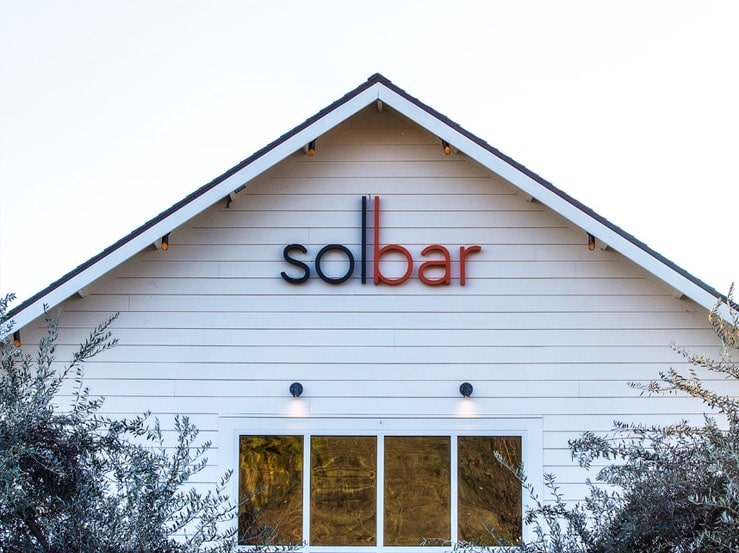
Napa Valley Restaurants
Napa Valley has almost as many restaurants as there are wineries, ranging from mom-and-pop diners to Michelin-star restaurants run by famed chefs. It is well known as a destination for culinary delights, with some restaurants becoming destinations in and of themselves.
It’s always difficult to choose where to eat, and much depends on timing, palate, pocketbook, and availability of reservations. Given the plethora of dining options, this is but a small list of those Napa Valley restaurants that are worth your time, offer incredible food, and are considered the ones that you should endeavor to visit in the valley.
The 20 restaurants listed below are sorted by price, as there are many great finds to be found across the spectrum. Click on the link below to find more details (address, description, etc.) on each of these Napa Valley restaurants.
Cheap Eats ($)
Moderate Meals & Treats ($$)
Expensive Cuisine ($$$)
High-End Eateries ($$$$)
Napa Travel Tip!
Many of these Napa Valley restaurants require reservations, often 3-6 months or more in advance depending on the time of year you plan on traveling to Napa Valley. If there is a particular restaurant you have to try, book the date and work your trip around that special meal.
Napa Valley Hotels & Accommodations
The majority of visitors to the Napa Valley stay over, and there is no lack of options. When it comes to Napa Valley hotels and accommodations, they run the gamut from B&Bs to 5-star resorts, family run hotels to cottages and condos at Silverado Resort.
Much like the wineries and restaurants, there are just too many options to mention, so let’s take a look at some of Napa Valley’s best and most unique accommodations, along with others that offer additional services.
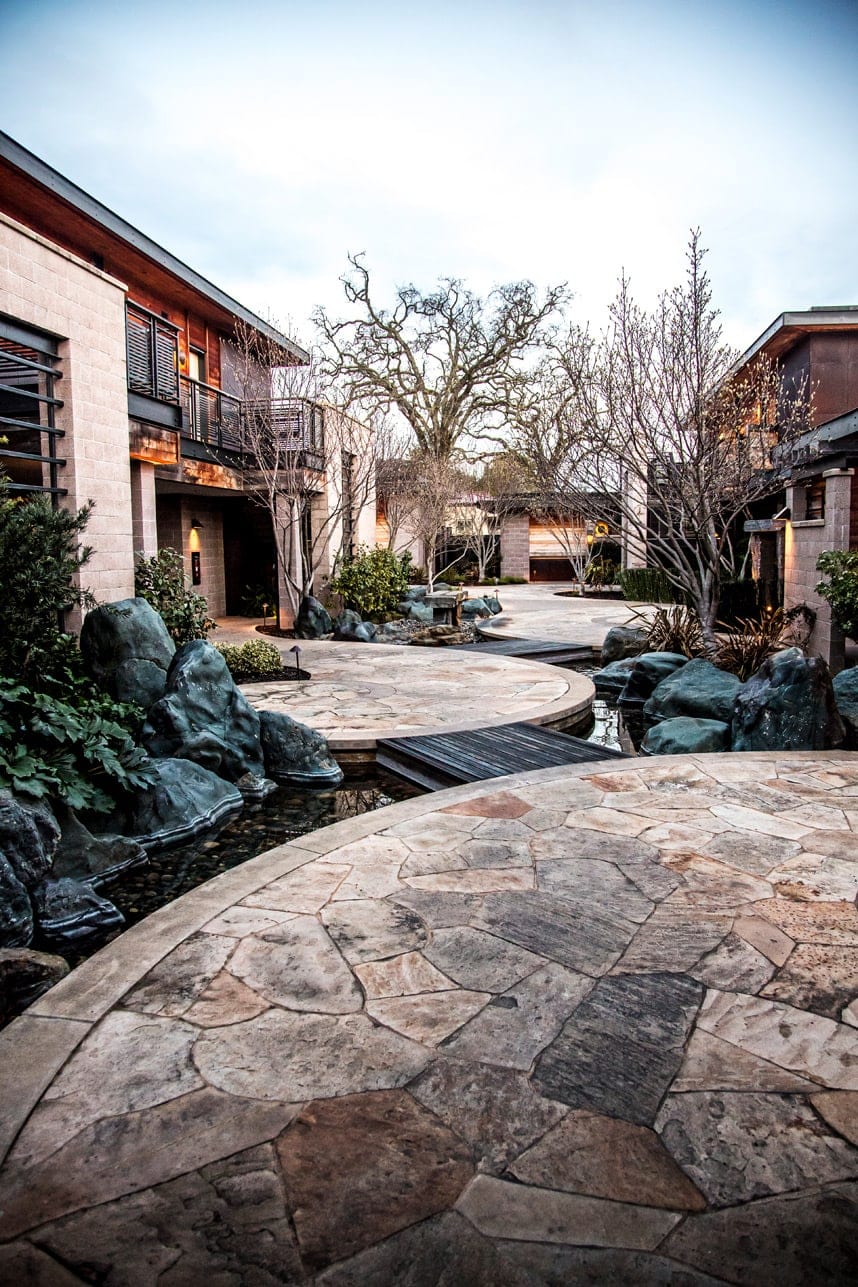
Auberge de Soleil: Possibly the most high-end resort and hotel in the valley, this French-inspired guesthouse sets the standard for luxury. Set high into the hills, guests have a beautiful view of the valley, the option to partake in a world-class spa and eat at a Michelin-star restaurant, all without ever leaving the property.
Brannan Cottage Inn: This Victorian B&B has been faithfully restored from its 1860 origins, and is one of the few local homes on the National Register of Historic Places. It was also named one of USA Today’s 10 Best Romantic Places to Stay in Napa Valley. Perfect place to bring your sweetie.
Cabernet House: A cross between a B&B and small European inn, the Cabernet House is located in downtown Napa and is known as one of the Top 10 B&Bs in the U.S. With only 8 rooms, the focus is on guests, from handcrafted breakfast in the morning to the house-made chocolates each evening.
Casa Lana B&B: What sets this small Mediterranean-style inn apart are their Gourmet Retreats. Guests can try a half-day class, spend the weekend in the kitchen, or attend their 3-day Culinary Learning Vacation or Culinary Boot Camp.
Hotel Bardessono: This unique Yountville hotel is dedicated to being as green as possible, from the wood milled to build the property to the geothermal heating system, the local produce in the restaurant and spa to the recycling and composting throughout the property. This is “green” luxury at its finest. Bonus: Complimentary bikes to tour the town or the valley. (View more photos & read my write-up on Bardessono: A Napa Valley Hotel to Swoon Over – Bardessono.)
Meadowood Napa Valley: This luxury resort is comprised of an award-winning hotel, Michelin 3-star restaurant, and a spa that was named “Best New Spa & Wellness Property” at the 2016 Wellness Travel Awards. Accommodations range from cozy rooms in the main hotel to large suites (1745 sf) in Hill House to Hillside Lodges with two to three bedrooms, perfect for large families or get-togethers.

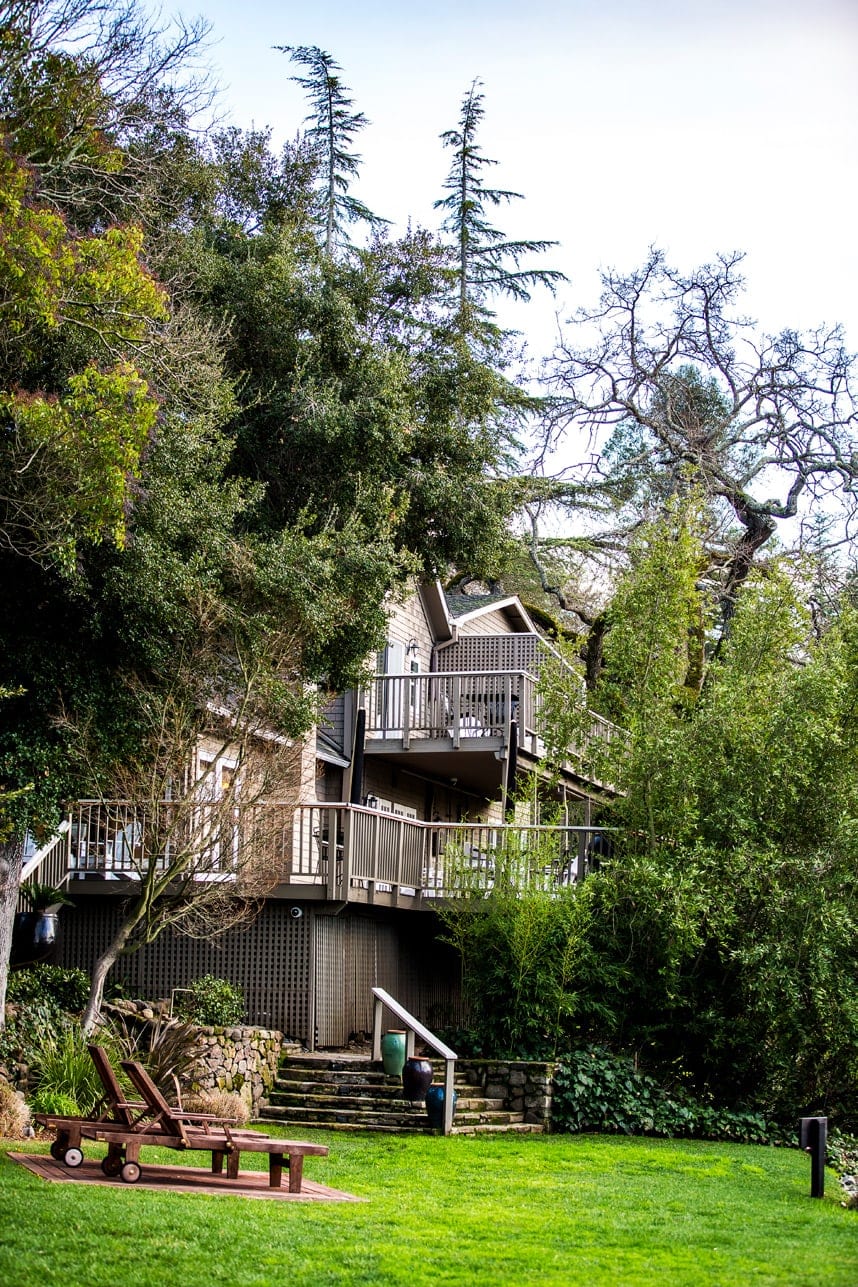
Meritage Resort: This 4-Diamond resort is the epitome of luxury, surrounded by the beauty of vineyards. Stay in one of their elegant rooms and enjoy some pampering at Spa Terra, located in the subterranean “Estate Cave.” Enjoy a meal at one of the award-winning restaurants and then head to Crush Ultra Lounge for a craft cocktail and a turn on one of the bowling lanes. (View more photos & read my write-up on Meritage Resort: The Meritage Resort and Spa – Simple Abundance)
Milliken Creek Inn & Spa: If it’s romance you’re looking for, then this small 12-room inn is the perfect retreat. Located in downtown Napa with a view of the river, you can enjoy a complimentary breakfast, afternoon wine reception, or partake of their spa offerings. (View more photos & read my write-up on Milliken Creek Inn: The Perfect Napa Valley Inn for a Romantic Getaway)
Mount View Hotel: This modern boutique hotel in Calistoga has guest suites named after wineries, but what is most intriguing is their Artist Cottages. These studio cottages provide visitors with artist’s easel, paints, and canvas to bring out your creative side. The private patios with Jacuzzis aren’t a bad amenity either!
Poetry Inn: Nestled into the hillside above Yountville, this small luxury hotel provides visitors with private terraces with which to overlook the vineyards of the Napa Valley. Sleep on Italian linens, relax in the soaking tub, or warm your bones after a long day by the wood-burning fireplace in your room.
Silverado Resort and Spa: What sets this large resort apart is the variety of options for accommodations. There are the traditional hotel rooms and suites at Mansion Estates and The Cottages, along with one-to-three bedroom condos in Oak Creek East, and one-to-three bedroom cottages in The Grove that overlook the fairways of the South Golf Course. All the onsite amenities—golf courses, tennis, spa, pool, etc.—make this a great place for families and couples traveling together.
Solage Calistoga Resort & Spa: Set on 25 acres, guest rooms are dotted around the property in individual buildings. With a unique mix of casual and luxury, you’ll find the rooms spacious, the spa glorious, and the food at SolBar worthy of a Michelin star (which it has). Bonus: A fleet of Mercedes for car-less visitors to use to tour the valley. (View more photos & read my write-up on Solage Calistoga Resort: Enjoy Endless Relaxation in Napa Valley)
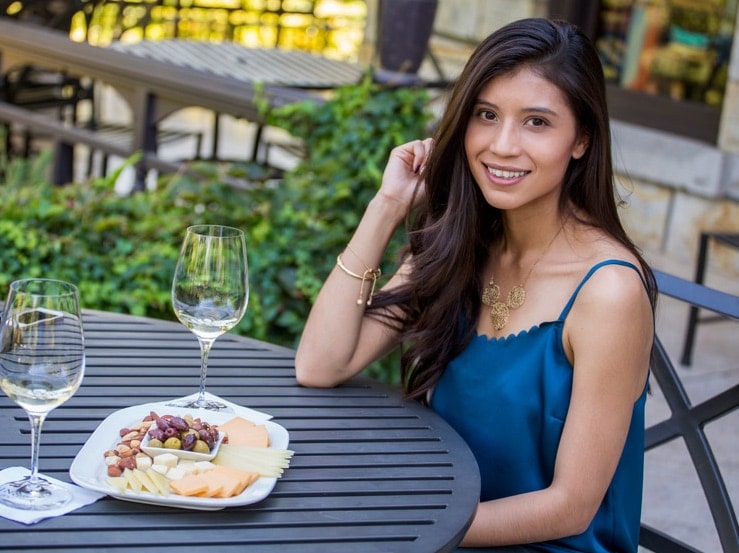
What to Wear to Napa Valley
When you make a visit to the Napa Valley, your attire will be dependent not only on your own sense of style, but the weather and the activities that you’ll be participating in. While there is no dress code for most venues in the valley, it seems inappropriate to wear jean cutoffs when tasting $150 bottles of wine or to go hot air ballooning in a tank top (it’s mighty chilly up there at 3,000 feet!).
You’re best bet, year round, is to stick to stylishly casual during the day and have some fancier duds for evenings when you’ll be dining out. That way, you won’t feel out of place whether you’re at a winery, grabbing lunch at Gott’s Roadside drive-in, shopping downtown, or eating a gourmet dinner at a Michelin-star restaurant.
You will, of course, have to make adjustments to this recommendation if you intend to play golf or tennis, bike, hike, or go horseback riding. Specific activities such as these require their own type of sportswear. (And if you’re going to ride in that hot air balloon, make sure you have several extra layers to take the chill off while aloft.)
During the warmer months, dresses, skirts, capris or ankle pants are all good choices for women. You can also wear nice shorts, but make sure the length is mid-thigh or lower. Due to the heat, you’re better off wearing a looser flowy top that won’t stick to the skin or wearing natural materials like cotton, linen, or silk. Make sure that you have a light layer for colder mornings, tours through wine caves, and for evening breezes. For inspiration, check out this post on stylish wine tasting attire.
Flats, sandals and wedges are all good options. I wouldn’t advise heels during the day as many of the wineries and older downtowns have uneven ground, making it hazardous to ankles. A flat or wedged sole will work best and provided that needed stability. And since you’ll probably be doing a good amount of walking while touring the Napa Valley, it’s advisable to have comfortable shoes that fit well and won’t pinch or cause blisters.
For men, khakis, tan, or dark-wash denim are all good options for daytime in the spring and summer. Again, shorts are an option, but leave the basketball, board, and cutoff shorts at home. Opt instead for a fitted cargo short, golf short, or similar style. Lightweight cotton button-down shirts and polos are both easy options to pack and wear. When it comes to casual footwear, look to boat/deck shoes, driving mocs, athletic shoes, or sandals.
Check out these wine tasting outfits for inspiration and these 10 style tips on what to wear to a winery.
When it gets a bit chillier during the fall and winter months, you’ll need to modify your wardrobe a bit. The biggest tip here is to layer up. You’ll go from a warm car to the chilled air, into a warm tasting room or store, and then out into the cold air of the vineyards, cave tour, or shopping district. The constant change in temperature dictates two to three layers.
For women, the layers can include long-sleeve tees, button-down shirts, or a lighter weight sweater or turtleneck as the first layer. You can then add a heavy sweater or cardigan, blazer or jacket, along with a scarf or hat. For rainy days, a raincoat or trench works nicely. You’ll want to stick primarily with pants to keep the chill off your legs during the day. Dark wash jeans, colored jeans, khakis or business casual pants are all good choices. Pair them with a flat, bootie, ankle boot, or go with knee-high boots for extra protection from the elements.
Fall style inspiration for women can be found here and here, fall outfit essentials.
When it comes to fall and winter attire for men, they can actually follow much of what a woman would wear. Start with some basic pants—dark-wash jeans, khakis, corduroy—then add a button-down, turtleneck, or long-sleeve polo. Top it all off with a shawl-collared sweater (perfect to keep the neck warm), leather jacket, or cargo jacket and you’re good to go. Stick to shoes or boots that can withstand a bit of water or mud for walking in rain, muddy parking lots, or vineyard tours.
It’s wise to pack a fancier outfit or two if you’ve made reservations at one of the $$$ or $$$$ restaurants in the Napa Valley. Restaurants like the French Laundry require jackets (tie optional) for men and women will need to don business professional (or fancier) clothing. And it certainly would not be out of place to dine in a full suit for men and LBD or its equivalent for women. (Think about breaking out that dress you love that sits in the back of the closet and put it to good use!)
Whatever you wear, make sure it fits you well and suits your personal style.
Sample Napa Valley Itinerary
There are so many things to do in the Napa Valley, it can often be difficult to choose. We’ve assembled two sample itineraries, which cover a variety of activities. Both include wine tasting in the mix, but you can certainly replace those time slots with something else if you so desire. We’ve given you lots of ideas and suggestions in the Activities portion of this guide.
3-Day Itinerary (Friday-Sunday)
Day 1:
10 a.m. Breakfast at Grace’s Table in Napa. Their specialty pancakes, homemade (huge) English muffins, and egg dishes are all to die for. No reservations and you may have to wait, but it’s worth it.
12 p.m. Shop the Oxbow Market. Take a full tour to see all the stalls and then grab a coffee from Ritual Coffee Roasters and take your time on the second turn through the market. Make sure you grab a nosh or some treats for later in the day—you’ll have plenty of options to choose from! If you have time, head next door to The Store at CIA Copia and peruse their offerings of home goods, culinary delights, and wine.
2 p.m. Tour of the Palate at Hess Collection Winery. Enjoy the guided tour of the Art Museum, along with a pairing of 3 wines with creations from Executive Chef Chad Hendrickson.
4 p.m. Stop in at V Marketplace for wine tasting at the salon, featuring Chiarello Family wines, among others. Wander around the many boutiques and galleries.
6 p.m. Check into Hotel Bardessono. Relax on your terrace with a glass of wine before preparing for dinner.
8 p.m. Time for dinner! Hopefully you’ve planned ahead and are ready to splurge at The French Laundry, Bistro Jeanty, Bouchon or one of the other terrific restaurants that Yountville has to offer. If not, the concierge at Bardessano will happily find you a wonderful place to have your evening repast. (Make sure that you also secure reservations for tomorrow night!)
Day 2:
9:30 a.m. Breakfast at Lucy—inside the Bardessano—where you’ll taste some incredible local field-to-fork fare. Or just order breakfast in and have breakfast in bed. You can also jump out of bed early for a delicious fresh pastry and Bouchon Bakery.
11:30 a.m. Sparkling Deconstructed Tasting at Domaine Chandon. You can get your bubbly fix here with a tour and education that starts with tasting their base wine and progresses to a selection of their excellent sparkling wines.
1:30 p.m. Head to Archetype in St. Helena for brunch. (The duck confit with buttermilk waffle is to die for!)
3:00 p.m. Stop in at Beringer Winery for the Reserve Tasting Bar in the Rhine House.
4:30 p.m. Time for a little shopping in downtown St. Helena. Wander up and down the 5-block long shopping district and enjoy the boutiques, galleries and confections at Woodhouse Chocolate.
6:00 p.m. Make your way back to Bardessano for a little relaxation.
8:00 p.m. The dinner hour has come yet again. The venue is based on whether you made reservations ahead, the concierge made them last night, or you are willing to wing it. Any way you look at it, you are very likely to enjoy your meal.
Day 3:
9:00 a.m. Check out of Bardessano and head to Calistoga for a 10 a.m. spa experience at Indian Springs Resort and Spa. Start with a traditional mud or mineral bath, followed by a massage.
12:00 p.m. Brunch at Solbar at the Solage Resort. Try and score a seat out by the pool if the weather is good.
2:00 p.m. Time to ride the aerial tram up to Sterling Vineyards for a self-guided tour and tasting. Make sure you take a few pictures from the terrace, which has a view of the whole valley. Spectacular and the perfect way to end your weekend.
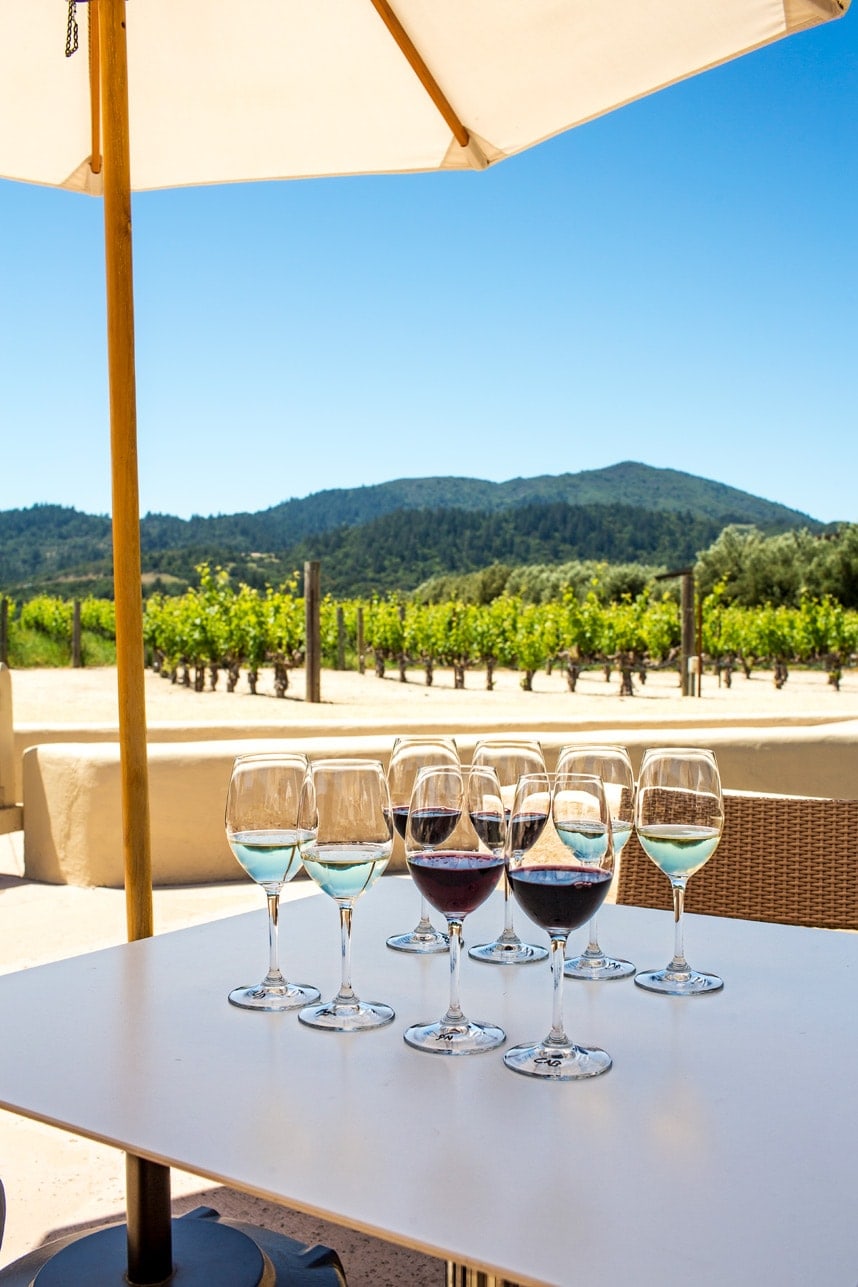
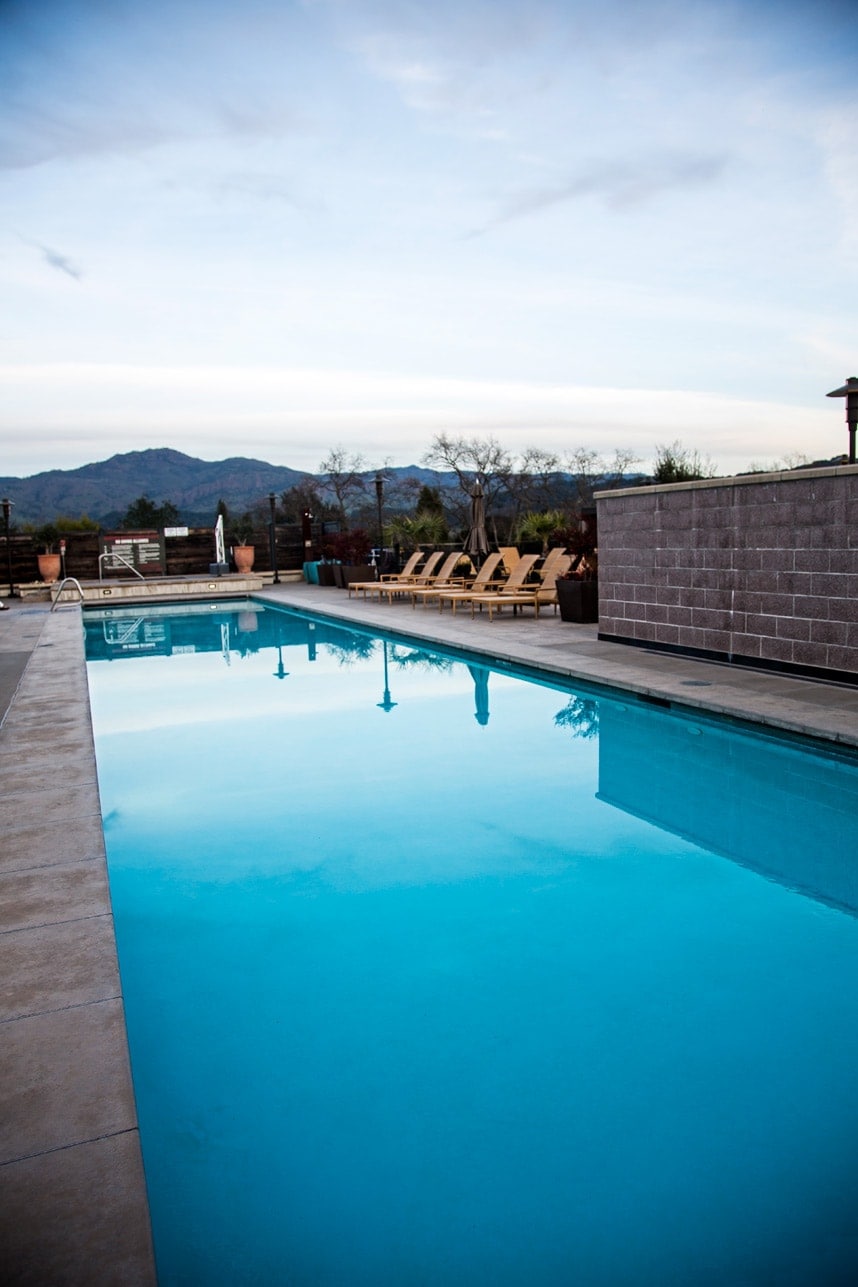
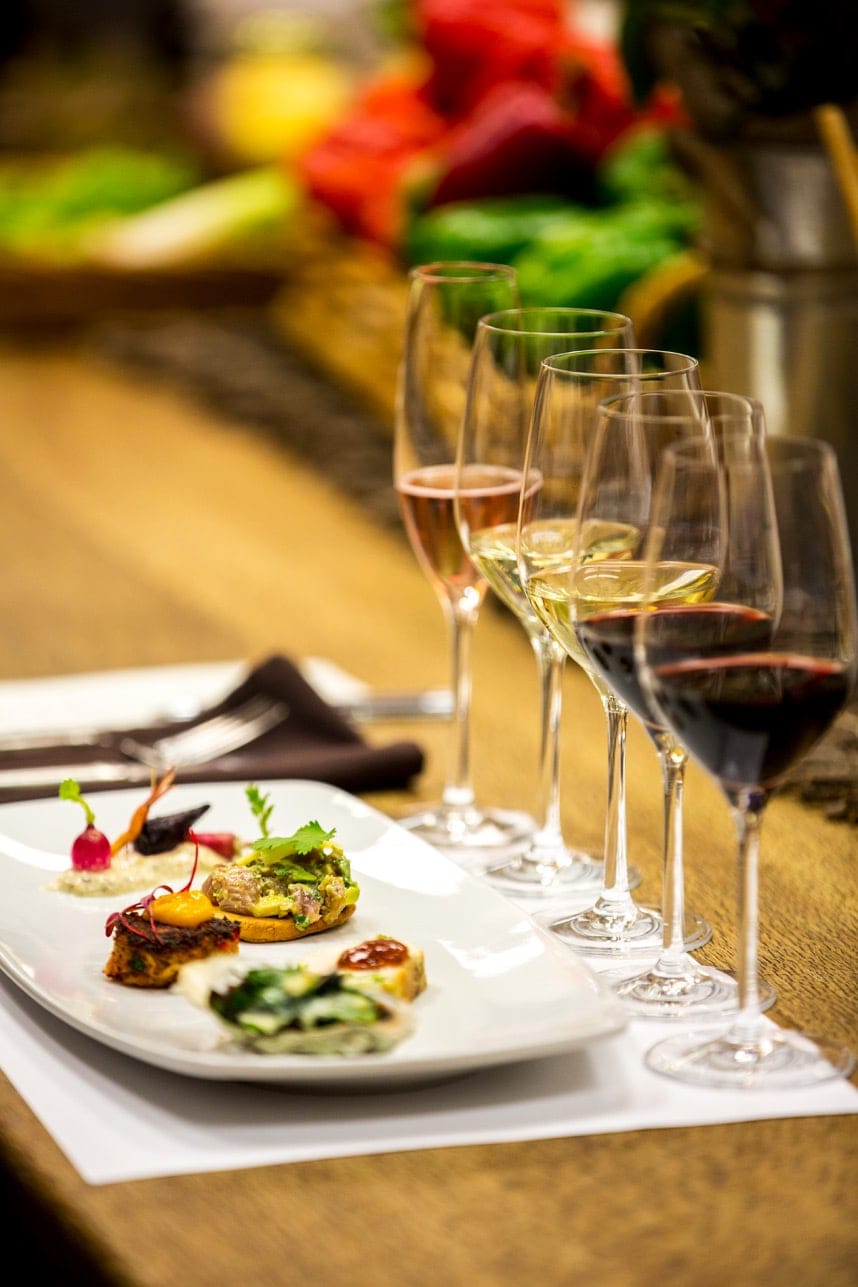
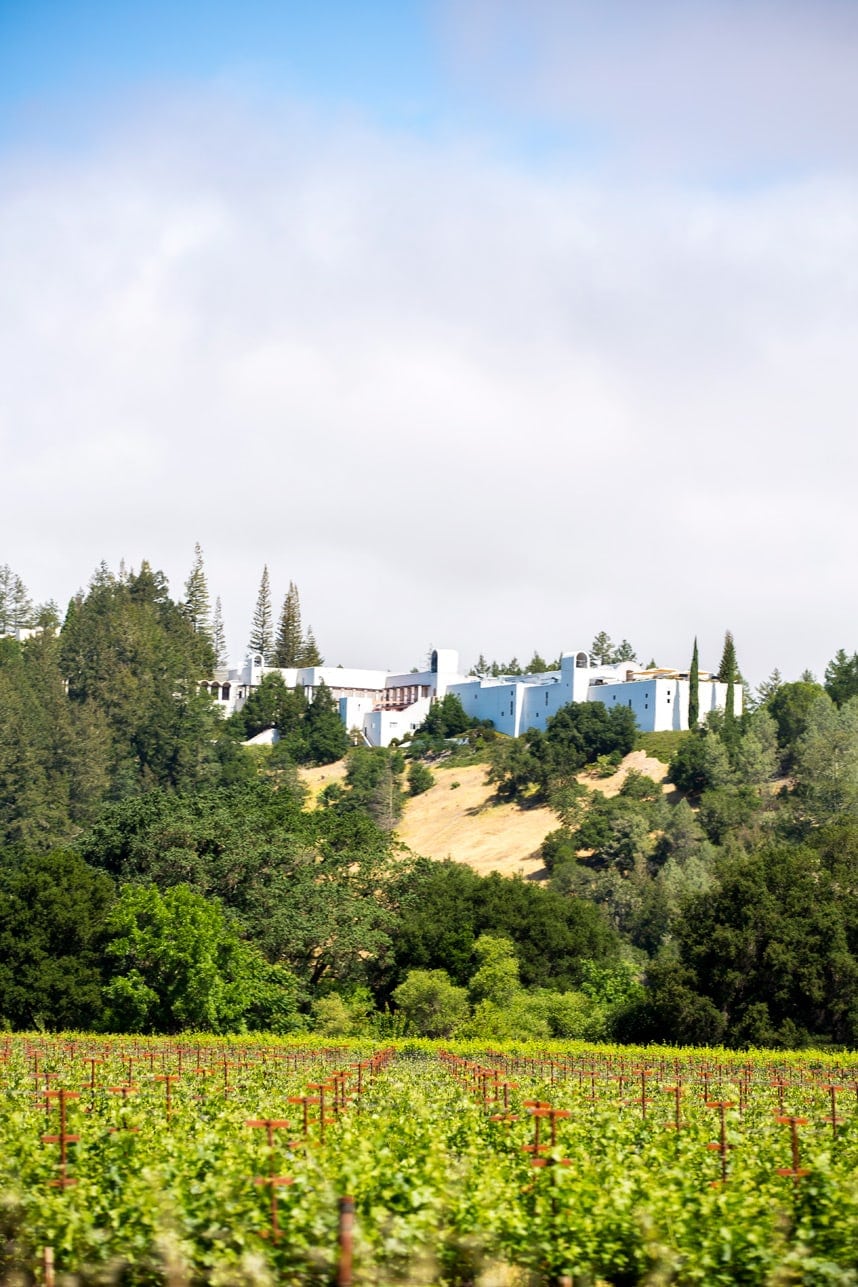
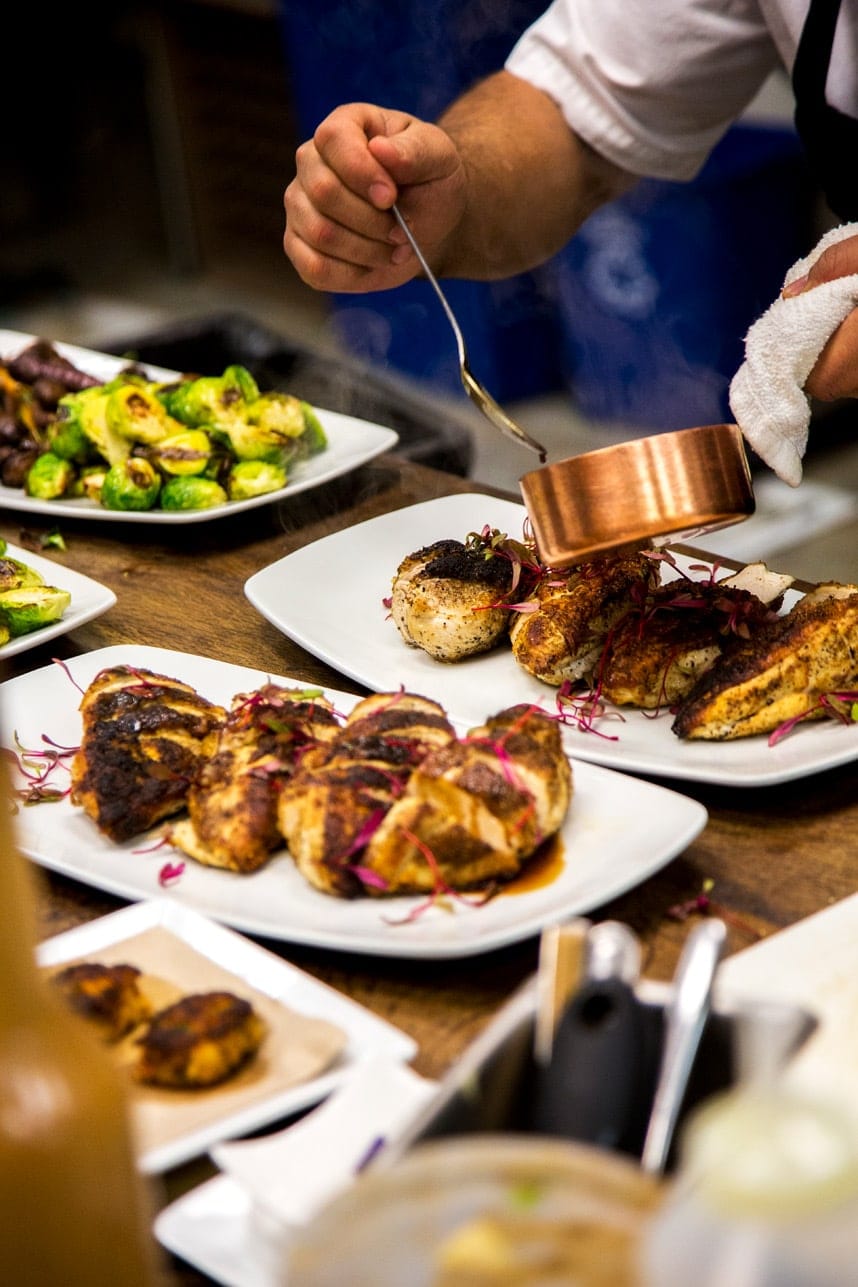
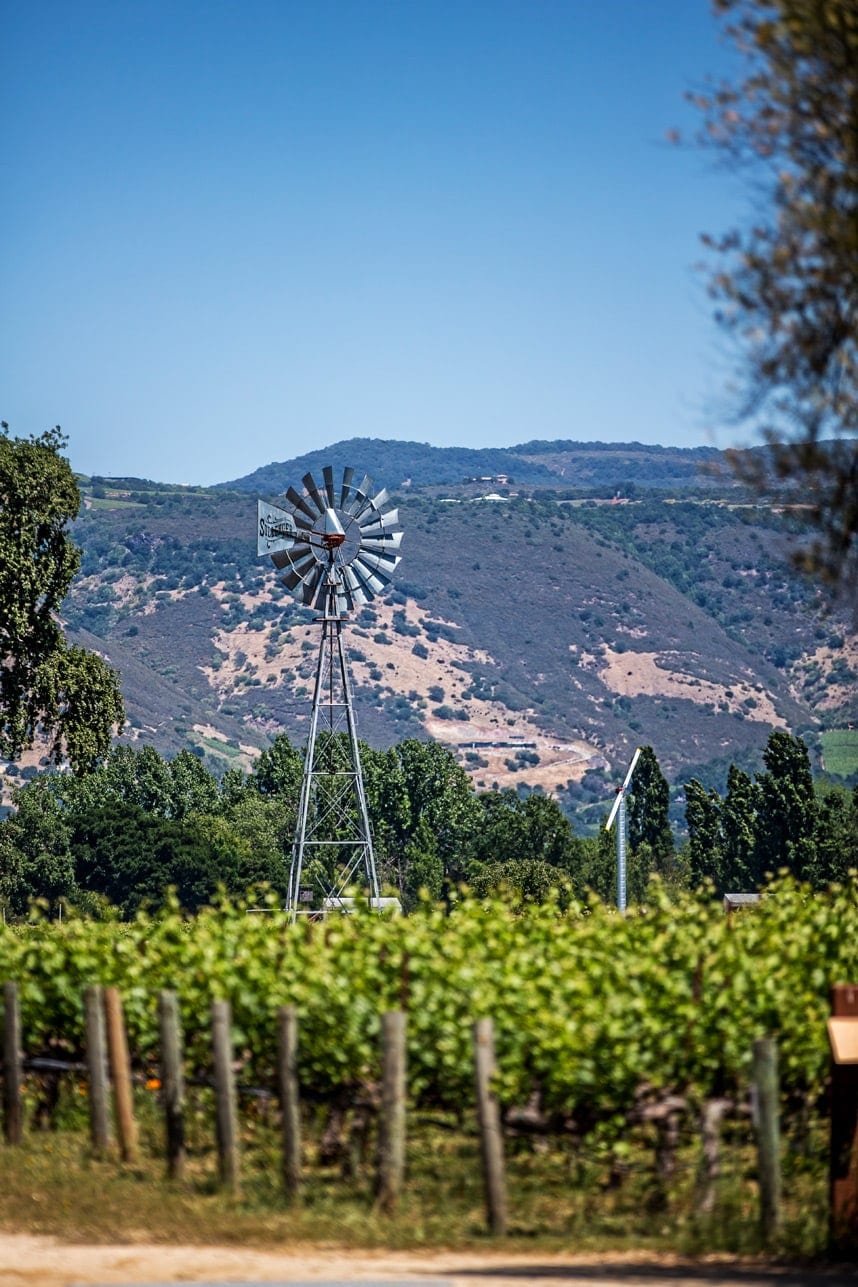
5-Day Itinerary
Day 1:
10:00 a.m. On your way into town, stop and shop at Napa Premium Outlets. Wander around the 50+ stores for designer goods, clothing, jewelry and housewares.
1:00 p.m. Time for the Perfect Circle Tour at Robert Sinskey Vineyards. Walk through their culinary gardens, vineyard, production facilities, and into their aging caves, followed by a wine flight and seasonal dishes produced from their own gardens.
4:00 p.m. Shop the Oxbow Market. Take a full tour to see all the stalls and then grab a coffee from Ritual Coffee Roasters and take your time on the second turn through the market. If you have time, head next door to The Store at CIA Copia and peruse their offerings of home goods, culinary delights, and wine.
6:00 p.m. Check into Cabernet House in Napa. Settle in and relax with a glass of wine at their wine reception in the salon.
8:00 p.m. Dive into some Italian food downtown at Bistro Don Giovanni. If the weather is nice, you can ask to dine alfresco on their patio.
Day 2:
9:00 a.m. Enjoy your breakfast in the dining room or, if you prefer, in your room as you ready for the day.
11:00 a.m. Attend the Bottle Blending Day Camp at Judd’s Hill. The perfect wine education that allows you to blend and craft your own wine. You’ll bottle cork and label 4 bottles to take home to show off to friends and family.
3:00 p.m. Saddle up at Napa Valley Horse Company for a ride through Napa Valley vineyards.
5:30 p.m. Time to head back to Cabernet House for a relaxing bath or nap.
7:00 p.m. Plan in advance for a big splurge and decide if you want treat yourself to a meal at Morimoto Napa, The French Laundry, Bouchon, or Bistro Jeanty. If planning isn’t your thing, then the concierge can help you find a table at one of the fine restaurants nearby.
Day 3:
8:30 a.m. Breakfast in the dining room, and then it’s time to pack and check out of Cabernet House.
10:30 a.m. Start with the Secret Garden Tour at Hill Family Estate. In addition to their vineyards, you’ll wander through their orchards (120 different fruit trees!), vegetable and herb garden, and flower garden. When complete, make your way back to their tasting room for a sip or two and see the antiques (and baseball bats) that have been refinished with stains made from their wines.
12:30 p.m. Make a pit stop at Gott’s Roadside in St. Helena for one of their artisan burgers and their delish sweet potato fries.
1:30 p.m. Wind your way up the mountain in St. Helena to Charbay Artisan Distillery and Winery to check out their imported copper stills and their hand-distilled spirits (whiskey, tequila, vodka, rum, vodka, brandy, and liqueurs).
4:00 p.m. Check into one of the Artist Cottages at Mount View Hotel. Settle in and take the provided artist’s supplies to your private patio and let the creative side take over.
7:00 p.m. Gear up for a delicious farm-to-table meal at Farmstead at Long Meadow Ranch in St. Helena. Request to eat at their communal table to compare notes with other visitors to the valley.
9:30 p.m. Return to your cottage and enjoy the Jacuzzi on your patio.
Day 4:
8:00 a.m. Balloon & Bike Tour, courtesy of Calistoga Balloons and Calistoga Bikeshop. Float around the valley for an hour, followed by a hearty breakfast. Then hop on a bike and follow the carefully planned wine-tasting tour.
4:00 p.m. Return to your cottage for a well-deserved nap!
7:00 p.m. Take a reprieve from wine and head downtown. Wander around the shops and stop in at Calistoga Inn & Brewery. Indulge in a beer tasting from this boutique brewery, then move over to the hotel’s restaurant for a casual meal on the patio.
Day 5:
9:00 a.m. No visit to the Napa Valley is complete without a spa experience. Take advantage of the spa in the Mount View Hotel and opt for the Mud City Sampler or The Big OM.
11:30 a.m. Time to check out and head south.
12:00 p.m. Stop in St. Helena for brunch at Archetype. (The duck confit with buttermilk waffle is to die for!)
2:00 p.m. Wander around downtown St. Helena, picking up some sweet treats at Woodhouse Chocolates, small-batch roasted beans at Napa Valley Coffee Roasting Co., or a piece of pottery from a local artisan.
As you can see, there is no shortage of activities, sights, wine, food or joy in the Napa Valley. Whether you are traveling alone, as a couple or family, or as a group, there is plenty to keep you buy, happy, sated, and ready to come back for more!
Happy Travels!
Vanessa
Get Travel Updates
Subscribe to receive all our travel tips via email!